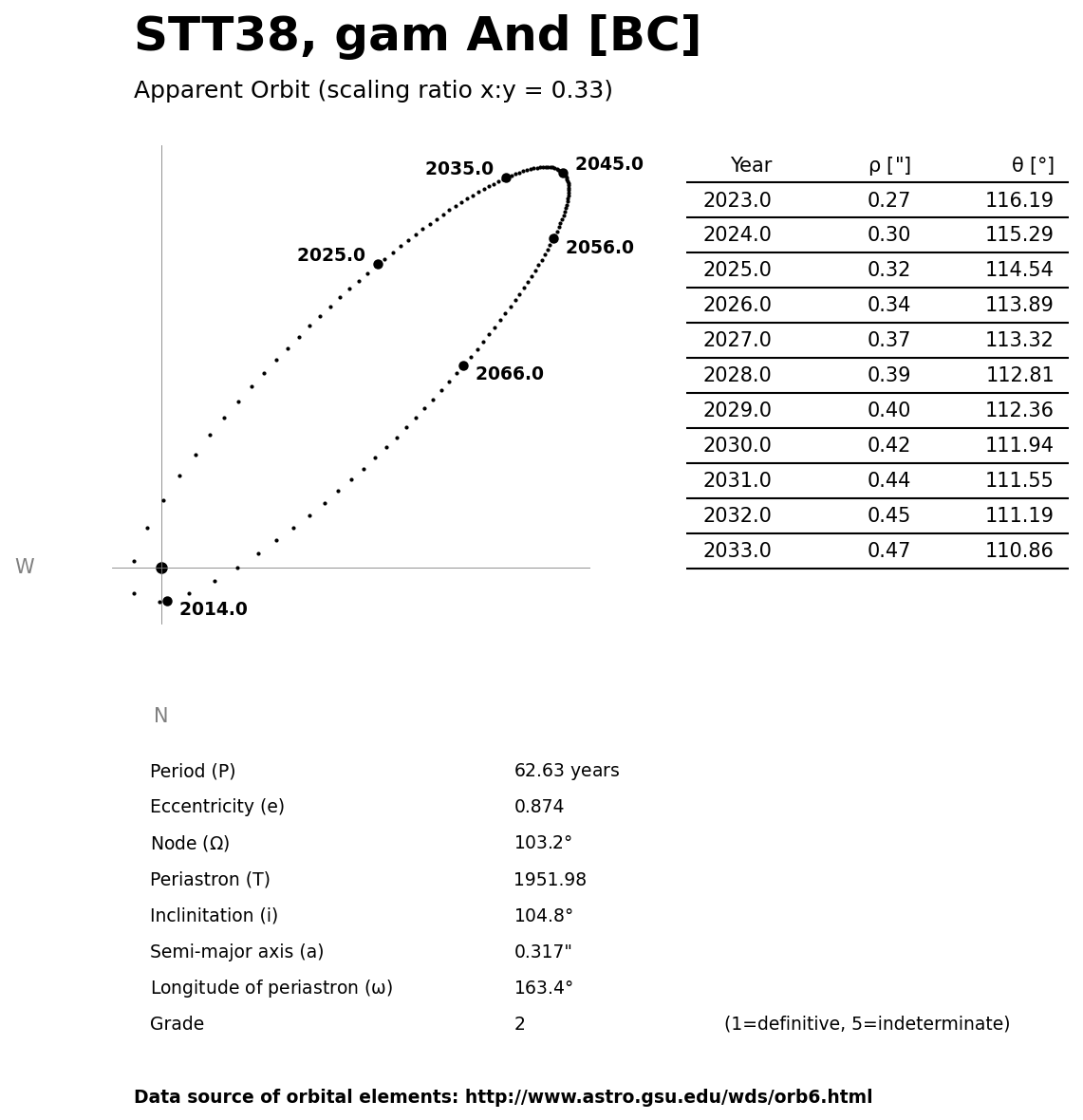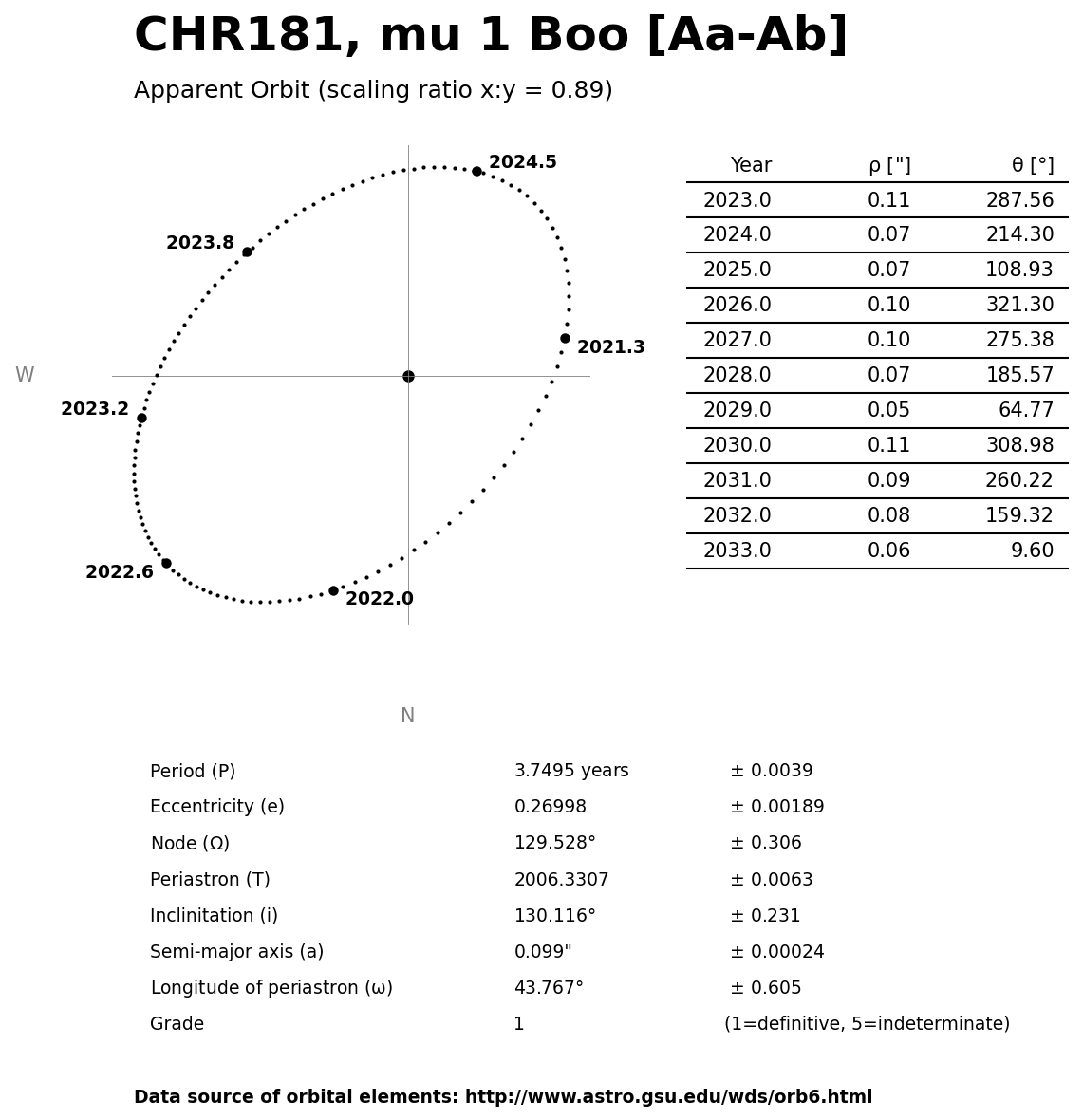|
m1 |
m2 |
ρ |
θ |
Year |
|
Coordinates (J2000.0) |
|
★★★
|
STTA254, WZ Cas |
|
AB |
7m.4 |
8m.3 |
57.8" |
89° |
2019 |
Cas |
00h01m15.85s / +60°21'19.00" |
|
|
|
|
AC |
7m.4 |
9m.6 |
155.4" |
324° |
2015 |
|
|
|
|
|
|
AD |
7m.4 |
10m.3 |
181.4" |
118° |
2016 |
|
|
Christopher Hay
Seeheim (Germany) |
6x24 |
AB: Clearly split. A definitely brighter than B. Under a NELM 5m5 sky both components appear weak in these mini-binoculars and no colour impression arises.;
WZ Cas is the variable designation of component A of STTA254. This semiregular carbon star has a mean brightness range of 6m8 to 7m7, and can reach extreme values of 6m3 at one end and 8m8 at the other. Perhaps it was too deep in a minimum at the time of observation to show colour with 1 inch of aperture? 15x45 binoculars revealed colour in this night, see observation below. |
|
Christopher Hay
Seeheim (Germany) |
15x45 |
AB: Wide split. A orange-red, B no particular colour. NELM 5m5, same night as 6x24 observation above. |
|
René Merting
Drachhausen (Germany) |
15x56 |
AB: einfach - beide Sterne zeigen sich komfortabel getrennt - Komponente A strahlt gelblich - Komponente B südöstlich wirkt dagegen grau und ist 1.5 bis 2 Größenklassen schwächer |
|
Robert Zebahl
Leipzig (Germany) |
16x70 |
AB: 2020-08-19: Intense orange & bluish. Very striking. |
|
René Merting
Drachhausen (Germany) |
16x70 |
AB: ein schöner Fernglas-Doppelstern - Komponente A im Westen präsentiert sich dunkelgelb (noch nicht orange), B im Osten ist eher weißlich |
|
René Merting
Drachhausen (Germany) |
18x70 |
AB: ein sehr auffälliger Doppelstern mit einem schönen Farbkontrast - A strahlt gelb, das kurz davor steht, ins Orange über zu gleiten - B wirkt im Kontrast aquamarin, so dezent wie eine typische PN-Farbe |
|
René Merting
Drachhausen (Germany) |
76mm (29x) |
AB: bei 29x ein wunderschönes Sternpaar mit einem auffälligen Farbkontrast, weit getrennt - Komponente B wirkt weißgrau bis weißblau gegen die gelborange strahlende A-Komponente - Helligkeitsunterschied eine Größenklasse |
|
René Merting
Drachhausen (Germany) |
76mm (29x) |
AB: Mondscheinbeobachtung - bei 29x ein weit getrenntes Pärchen, bei dem die A-Komponente nicht durch Strahlkraft, sondern durch seine auffallende Farbe besticht, ein sehr kräftiges Kupferorange - es gibt hellere Sterne im Umfeld, aber diese Komponente fällt besonders auf - die B-Komponente ist gut 1.5 mag schwächer und wirkt grau bis graublau |

|
Robert Zebahl
Leipzig (Germany) |
80mm (33x) |
AB: Nice double star. Brighter component appeared orange, the fainter more bluish. |
|
René Merting
Drachhausen (Germany) |
100mm (20x) |
AB: 20x reicht zwar schon für eine klare Trennung, aber Komponente B im Osten ist nur dumpf grau-blau und noch zu schwach für den schönen Farbkontrast, der sich bei 32x offenbart - Komponente A strahlt dann in einem satten Bernsteingelb, B im Osten gibt sich unterkühlt bläulich - Helligkeitsunterschied 1 bis 1.5 Größenklassen, schwierig abschätzbar wegen der Farben |
|
Sarah Gebauer
Germany |
100mm (49x) |
AB: sticht sofort ins Auge aufgrund des stärksten kupferroten Farbtons, den ich seit langem gesehen habe - der Begleiter strahlt bei 49-fach schon weit abgesetzt in einem graublauen, ganz kühlen Farbton |

|
Robert Zebahl
Leipzig (Germany) |
102mm (28x) |
AB: 2019-08-22: Splendid view. Primary component clearly orange, secondary blue. |
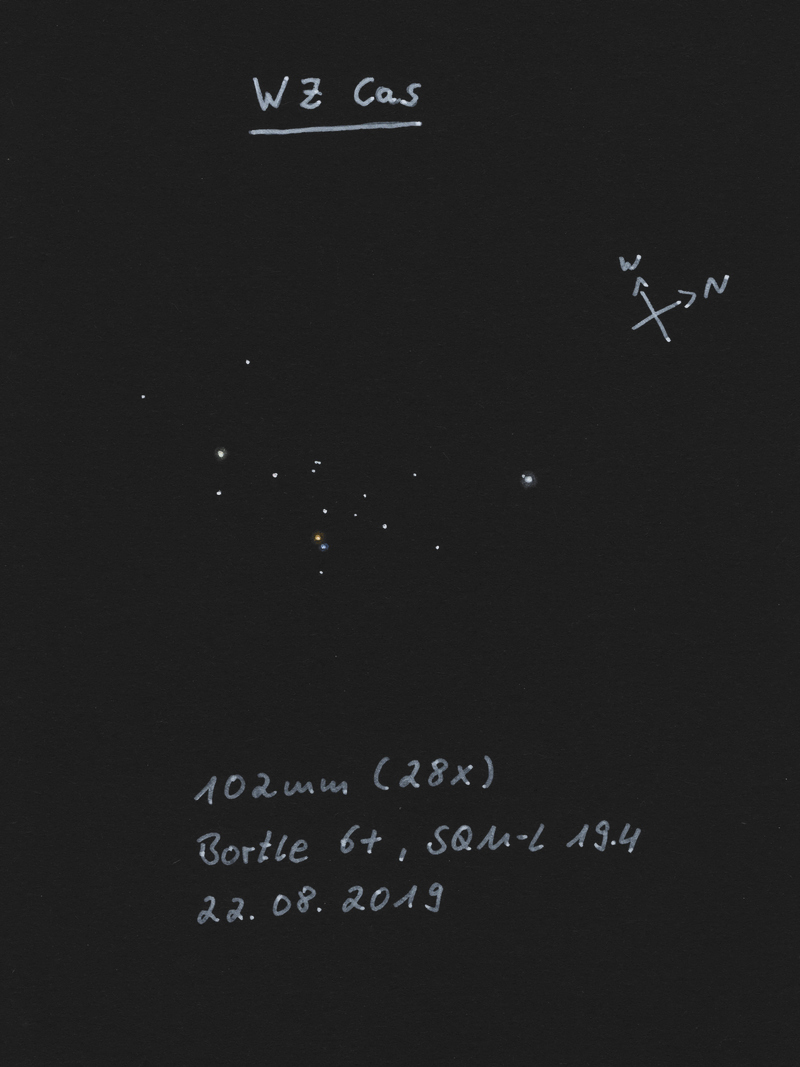
|
Jörg S. Schlimmer
Germany |
127mm (136x) |
Sehr schöner Farbkontrast |

|
Mark McCarthy
Fremont (California/USA) |
317mm (553x) |
AB: WZ Cas: Pretty, deep orange A and very wide half delta mag B, white. |
|
René Merting
Drachhausen (Germany) |
320mm (45x) |
AB: bei 45x ein weit getrenntes Pärchen mit wunderschönen Farbkontrast, Komponente A im Westen ist grell-orange und die gut 1.5 Magnituden schwächere Komponente B ist aquamarin-grau |
|
|
Robert Zebahl
Leipzig (Germany) |
102mm |
|

|
|
|
★★★
|
gamma And, 57 And, Alamak |
STF205 |
A-BC |
2m.3 |
5m.0 |
9.5" |
63° |
2021 |
And |
02h03m53.92s / +42°19'47.50" |
|
|
|
BAR22 |
AD |
2m.3 |
15m.0 |
27.9" |
245° |
1898 |
|
|
|
|
|
STT38 |
BC |
5m.3 |
6m.5 |
0.3" |
120° |
2021 |
|
|
|
|
Robert Zebahl
Leipzig (Germany) |
56mm (40x) |
A-BC: 2024-10-31: Nicely separated with a clear difference in brightness. Component A appeared in a bright yellow-orange. |
|
Robert Zebahl
Leipzig (Germany) |
63mm (42x) |
A-BC: Easy to split with quite large difference in brightness. |
|
Christopher Hay
Seeheim (Germany) |
71mm (32x) |
Fine split. A is mandarine orange. BC has trouble displaying its colour due to the overpowering light of A, but in good moments is clearly blue.
A-BC is a physical double at a distance to us of 393 light years.
BC is also physical, with a relatively short period of 63 years for C to circle B and a very tight periastron. Unobservable in 2013 at periastron with 0.1". Since then the angular separation has been widening rapidly and will reach 0.4" in 2029. B-C will then become observable in large amateur telescopes for three decades, after which C will fall quickly back to B. |
|
René Merting
Drachhausen (Germany) |
76mm (29x) |
A-BC: bei 29x äußerst knapp getrennt - Komponente A strahlt buttergelb, BC schmiegt sich im Nordosten an |
|
Uwe Pilz
Leipzig (Germany) |
105mm (52x) |
A-BC: einfach |
|
Uwe Pilz
Leipzig (Germany) |
120mm (128x) |
A-BC |

|
Robert Zebahl
Leipzig (Germany) |
152mm (100x) |
A-BC: Very easy. A: orange, BC: rather white. |
|
Christopher Hay
Seeheim (Germany) |
180mm (110x) |
A very strong pair in 0.6° FOV with powerful colour contrast, A yellow, BC ice blue. |
|
Sarah Gebauer
Germany |
254mm (96x) |
A-BC: in Dänemark als Startstern für die Suche nach der Galaxie NGC 891 gewählt und ohne Vorwissen spontan als sehr schönen Doppelstern erkannt: die Hauptkomponente strahlt richtig schön goldgelb, der Begleiter nordöstlich davon ist richtiggehend reinweiß und klein, wirklich toll! |
|
René Merting
Drachhausen (Germany) |
320mm (45x) |
A-BC: bei 45x ein knapp getrenntes Pärchen - Komponente A knallgelb mit einem Anhängsel nordöstlich - Komponente BC strahlt 3 Größenklassen schwächer - bei 144x wirkt BC grün-weiß, bei 45x war der Eindruck noch leicht gelblich |
|
Mark McCarthy
Fremont (California/USA) |
508mm (667x) |
BC: Component of STF 205, of which A is a brilliant orange and BC bright blue. In BC I can only see elongation through the speckle at 667x and 1067x. Short 62.63 year period which will get "easier" to about 0.2" by 2045 |
|
Mark McCarthy
Fremont (California/USA) |
508mm (1067x) |
BC: I spent a good long while on this one, and tried hard to nail down the position angle. At 1067x, both with and without an apodising mask, but both times with a #80A light blue filter, which did seem to calm the diffraction a little, I had a clear view of the elongation with a strong sense of the weaker end being to the East or to the ESE. I also tried a 78% central obstruction mask, and while the diffraction became a grid, and the disks much smaller, I could clearly see the same elongation and weaker end, though at a much smaller scale. To my delight the current orbital solution puts the PA at 120.6-degrees, 0.179" separation, so I think I have detected it. I can't wait until 2033 when this becomes an easy pair! |
|
|
Winfried Kräling
Marburg (Germany) |
127mm |
A-BC: Aufnahme vom 11.09.2020 am 127/1200mm Refraktor mit Barlowlinse (~2.5x)
Weit getrennt, Komponente A: goldgelb bis orange, Komponente BC: weißlich blau |
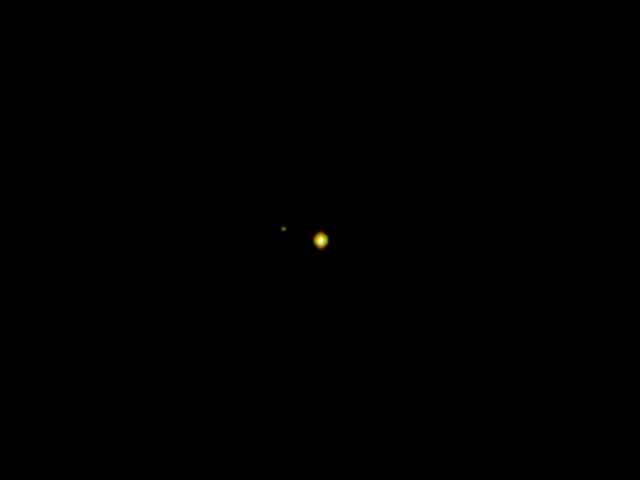
|
Werner E. Celnik
Rheinberg (Germany) |
150mm |
A-BC |

|
|
|
★★★
|
STF227, iota Tri, 6 Tri |
|
|
5m.3 |
6m.7 |
4.0" |
68° |
2019 |
Tri |
02h12m22.28s / +30°18'11.10" |
|
|
Robert Zebahl
Leipzig (Germany) |
70mm (57x) |
At 44x even separable with a clear difference in brightness, whereby the companion is almost outshone by the primary component. At 57x easy to separate. Primary component shines in bright orange, companion slightly orange. Beautiful sight together with STF232 in one field of view! |

|
Sarah Gebauer
Germany |
100mm (80x) |
25.09.23: mit 49-fach ist dieser noch nicht getrennte Farbdoppelstern eindeutig die Kommandozentrale des imperialen TIE-Jägers - bei 80-fach zeigt die A-Komponente einen sehr dunklen, gelbgoldenen Farbton und die sehr dicht stehende B-Komponente einen weißgoldenen Farbton |

|
Uwe Pilz
Leipzig (Germany) |
105mm (88x) |
weiß und blau |

|
Christopher Hay
Seeheim (Germany) |
180mm (110x) |
Well separated. Primary yellowish, secondary light blue. When 6 Tri drifts out of 0.6° FOV, STF232 drifts in.
6 Tri is a physical double at a distance to us of 291 light years. |
|
Mark McCarthy
Fremont (California/USA) |
203mm (205x) |
6 Tri. Yellow A, white b, pretty. Wide, about two delta mag |
|
Frederik Wanink
Itterbeck (Germany) |
254mm (200x) |
Helligkeitsunterschied deutlich |
|
René Merting
Drachhausen (Germany) |
320mm (103x) |
bei 103x zeigt A sich hellgelb, B ist getrennt, steht sehr dicht und ist auch noch sehr hell - Helligkeitsunterschied 1.5 Größenklassen, B ist grauweiß |
|
Karsten Kopp
Köln (Germany) |
600mm (180x) |
Doppelstern ist noch gut zu trennen und der Helligkeitsunterschied ist mit gut 1,5 mag schon sehr auffällig. Der hellere Stern erstrahlt schön gelblich, der schwächer weiß. In den Momenten der wirklich ruhigen Luft, ein sehr schöner Doppelstern |
|
|
|
★★★
|
STF231, 66 Cet |
|
AB |
5m.7 |
7m.7 |
16.8" |
235° |
2019 |
Cet |
02h12m47.54s / -02°23'37.10" |
|
|
|
|
AC |
5m.7 |
11m.5 |
147.0" |
53° |
1998 |
|
|
Christopher Hay
Seeheim (Germany) |
30x80 |
AB: Wide split. A is cream-white, B of indeterminate colour. Attractive pair in 1.7° FOV, scenery accentuated by 63 Psc about 3/4° to northwest.
While pleasant with 30x80, the pair becomes suprisingly difficult to split with 20x80, presumably due to the cumulative effect of 2m delta-mag and the red colour of the companion, which makes it stand out less than if it were blue (colour not seen, but stressed by Uwe Pilz in his 105mm observation, see below). |
|
René Merting
Drachhausen (Germany) |
76mm (29x) |
AB: bei 29x zeigt sich B südwestlich von A relativ schwach, gut 1.5 Magnituden schwächer - Komponente A wirkt weiß-gelblich, B dagegen nur grau-weiß, aber dennoch ein schöner Farbkontrast zwischen den beiden |
|
Uwe Pilz
Leipzig (Germany) |
105mm (88x) |
AB: weiß und leuchtend rot! |

|
Sarah Gebauer
Germany |
254mm (96x) |
AB: bei 96-fach ist der DS schön weit getrennt, ein unterschiedlich helles Paar – die Hauptkomponente strahlt warmweiß mit einem allerkleinsten Ansatz eines Hauches von Gelblich – der DS erhält zudem Konkurrenz durch einen benachbarten, nördlichen Stern, der sehr schön roségoldfarben strahlt und sogar einen „Begleitstern“ hat |
|
|
|
★★★
|
STF232 |
|
|
7m.8 |
7m.9 |
6.7" |
69° |
2019 |
Tri |
02h14m42.16s / +30°23'41.20" |
Robert Zebahl
Leipzig (Germany) |
70mm (22x) |
Very beautiful view! With all used magnifications together with iota Tri (6 Tri) in one field of view. Separable at 22x, but the components are still quite close together and appear similarly bright. At 44x easy to separate with little difference in brightness. At 57x a very small color difference is visible without being able to clearly name the colors. STF232 was sketched together with 6 Tri. |

|
Christopher Hay
Seeheim (Germany) |
180mm (110x) |
Wide separation. Very even brightness. Northeast secondary appears slightly bluish compared to primary. |
|
Mark McCarthy
Fremont (California/USA) |
203mm (205x) |
Pretty white stars, only a slight delta mag, well split |
|
René Merting
Drachhausen (Germany) |
320mm (45x) |
bei 45x knapp getrennt, zwei gleich helle Sterne - bei 103x zeigt der Doppelstern einen schönen, zarten Farbkontrast - der östliche Stern wirkt blauweiß, der westliche warmweiß |
|
Karsten Kopp
Köln (Germany) |
600mm (180x) |
Doppelstern einfach zu trennen und beide Sterne haben die gleiche Hellgkeit. Da beide weißlich strahlen, habe ich den Eindruck, als würden zwei Scheinwerfer aus dem All in unsere Richtung leuchten. |
|
|
|
★★★
|
STF93, alpha UMi, 1 UMi, Polaris |
|
AB |
2m.0 |
9m.1 |
18.4" |
236° |
2016 |
UMi |
02h31m49.09s / +89°15'50.70" |
|
|
|
|
AC |
2m.0 |
13m.8 |
39.0" |
103° |
2016 |
|
|
|
|
|
|
AD |
2m.0 |
14m.3 |
83.2" |
194° |
2016 |
|
|
Christopher Hay
Seeheim (Germany) |
71mm (32x) |
B well separated, a fine blue pinprick next to luminous yellow A.
Alpha UMi, Polaris, is a physical double at a distance to us of 433 light years. |
|
René Merting
Drachhausen (Germany) |
76mm (29x) |
AB: Mondscheinnacht - bei 29x zeigt sich ein schönes Sternpaar, knapp getrennt - B ist sehr schwach, aber noch gut zu erkennen - Helligkeitsunterschied enorm - das Paar ist dennoch sehr ansehnlich, zumal A in einem schönem Gelb strahlt |
|
Christopher Hay
Seeheim (Germany) |
76mm (40x) |
B well set off from A. Glare from A is an issue, consciously trying to ignore A helps. Very slight yellowish tone of A. Seeing the difficulty makes it clear why attempts in other nights to split the pair with 25x80 binoculars failed. |
|
René Merting
Drachhausen (Germany) |
100mm (32x) |
AB: bei 32x knallt die Hauptkomponente A schön hellgelb rein, Komponente B ist als feiner zarter Lichtpunkt knapp daneben erkennbar - Größenklassenunterschied nicht abschätzbar, auf jeden Fall riesig |
|
Sarah Gebauer
Germany |
100mm (49x) |
AB: bei 49-fach sauber getrennt, A ist sehr hell, warmweiß und erzeugt einen feinen Spike im Amiciprisma, B steht ausreichend weit entfernt, durch die Helligkeit von A aber doch wieder nicht ganz so weit abgesetzt und scheint mausgrau - bei 80-fach gewinnt A einen wesentlich gelblicheren Farbton und wirkt nun mittig weiß und ansonsten goldorange |

|
Christopher Hay
Seeheim (Germany) |
180mm (113x) |
B widely separated from A. A has definite yellowish hue. B luminous aquamarine blue, very attractive. |
|
René Merting
Drachhausen (Germany) |
320mm (45x) |
AB: bei 45x ist B sehr knapp getrennt von A erkennbar - Komponente A strahlt auf den ersten Blick weiß, bei genauerem Hinsehen mischt sich ein zartes Gelb unter |
|
|
|
★★★
|
AG304, 15 Tri |
|
|
5m.6 |
6m.8 |
142.4" |
16° |
2013 |
Tri |
02h35m46.82s / +34°41'15.20" |
Christopher Hay
Seeheim (Germany) |
7x50 |
Well split. Main star yellow-orange, secondary an ice-blue pinprick. With overall brightness of 5m1 just visible to naked eye under my suburban sky. Interesting star field with a line of 5 stars pointing S-SW away from 15 Tri and a further striking star chain to the west. Placing Gamma-Delta-7 Tri within 7.5° FOV makes a very attractive overall field. Mira variable R Tri just ½ degree to the S-SE was around maximum at time of observation and presented a much paler orange than 15 Tri A. Charming colour contrast ensemble with the two components of the double plus the variable. |
|
René Merting
Drachhausen (Germany) |
18x70 |
ein extrem komfortabel getrenntes Sternpaar - Komponente A im Süden strahlt weißgelb, B ist 1.5 Größenklassen schwächer und wirkt kupfergrau - interessant: parallel zu den beiden Sternen stehen westlich zwei deutlich schwächere Sterne in gleichem Abstand und Positionswinkel wie die Komponenten von 15 Tri - alle 4 Sterne bilden ein Parallelogramm |
|
Christopher Hay
Seeheim (Germany) |
80mm (30x) |
A beautiful, wide pair. Main star orangish yellow, secondary ice-blue. Attractive star field in 2.7° FOV: several similarly-separated pairs to the north and east, and two striking star chains to the south and west. |
|
Sarah Gebauer
Germany |
100mm (21x) |
ein wirklich schönes, farbiges Pärchen, das schon bei geringster Vergrößerung deutlich getrennt und in einem Eisblau und leichtem Orange strahlt, zudem bildet es mit der markanten Sternkette östlich davon, die im Refraktor mit Amiciprisma ein auf dem Kopf stehendes T bildet, ein tolles Gesamtbild |
|
Sarah Gebauer
Germany |
100mm (21x) |
25.09.23: mit 21-fach erinnert dieser Doppelstern fast an das Farbkontrastdoppel Delta Cephei, er ist weit getrennt und zeigt eine ganz klassisch warm gelbgoldene A-Komponente und in sehr weitem Abstand eine metallisch azurblau leuchtende B-Komponente |
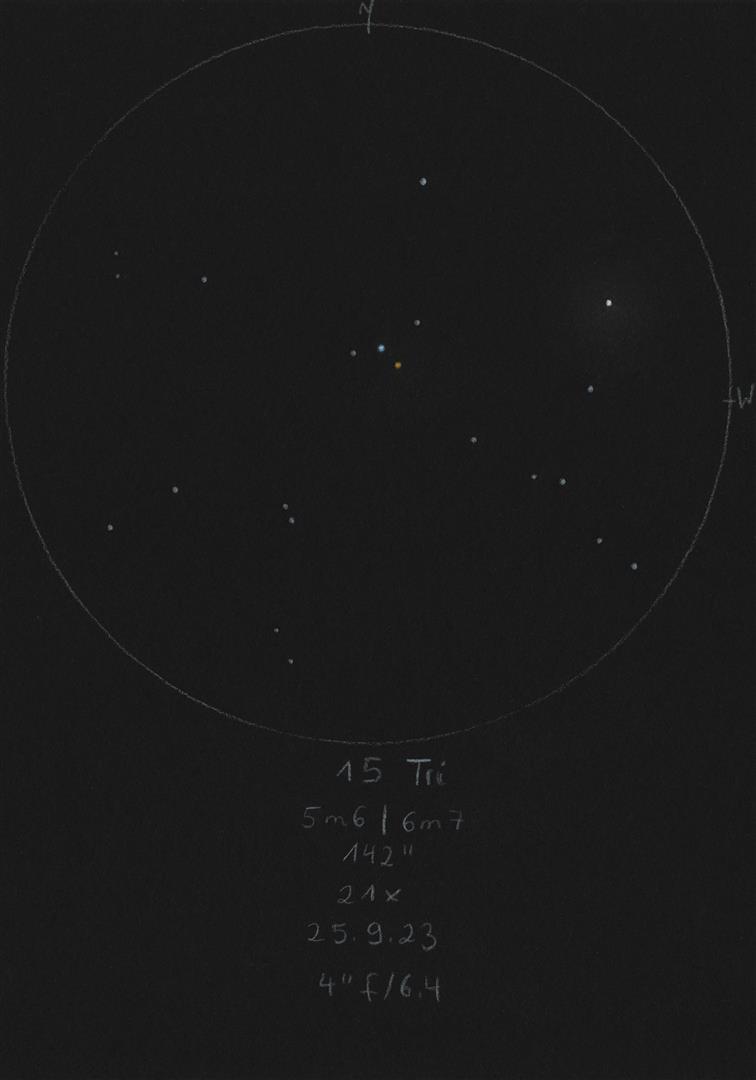
|
René Merting
Drachhausen (Germany) |
320mm (45x) |
bei 45x weit auseinanderstehend, aber dennoch schön anzusehen - A ist rapsgelb, B im Norden wirkt unterkühlt weiß bis graublau |
|
|
|
★★★
|
STF412, 7 Tau |
|
AB |
6m.6 |
6m.9 |
0.8" |
350° |
2019 |
Tau |
03h34m26.62s / +24°27'52.10" |
|
|
|
|
AB-C |
5m.9 |
9m.9 |
22.4" |
53° |
2014 |
|
|
|
|
Uwe Pilz
Leipzig (Germany) |
105mm (260x) |
AB: A-B länglich |
|
Christopher Hay
Seeheim (Germany) |
180mm (110x) |
No definite elongation of AB seen at 110x, seeing is poor. But nice pinprick of light wide off to NE, seems bluish, this is the C component.
AB-C is physical at 429 light years distance from us, and so is A-B, so this is a physical triple system. Very easy to find 3° due west of the Pleiades. |
|
Mark McCarthy
Fremont (California/USA) |
508mm (333x) |
AB: Exciting 2+1 set. AB is brilliant near equal white, nice close split <1". C is a much fainter wider star. I also cleanly split AB with the 8-inch mask, but the dark gap was narrower. Physical with a 522.16-year period |
|
|
|
★★★
|
STF470, 32 Eri |
|
AB |
4m.8 |
5m.9 |
6.9" |
349° |
2021 |
Eri |
03h54m17.49s / -02°57'17.00" |
Robert Zebahl
Leipzig (Germany) |
55mm (27x) |
At 27x split, but still tight with noticeable difference in brightness. A slight difference in colors could be seen. At 56x the color difference was very evident: The brighter component appeared slightly yellowish, the fainter one slightly bluish. Highly recommended! The sketch was done few days later during another observation. |

|
Uwe Pilz
Leipzig (Germany) |
105mm (144x) |
ab 26x trennbar |

|
Uwe Pilz
Leipzig (Germany) |
105mm (288x) |
Farbkontrast, gelborange-blauweiß |

|
|
|
★★★
|
STFA10, theta Tau, theta 1/2 Tau, 77/78 Tau |
|
AB |
3m.4 |
3m.9 |
336.9" |
347° |
2019 |
Tau |
04h28m39.74s / +15°52'15.20" |
Robert Zebahl
Leipzig (Germany) |
naked eye |
2023-02-15: Easy to separate with similar bright components, although colorless. |
|
René Merting
Drachhausen (Germany) |
naked eye |
wunderbar, der Doppelstern kann ich mit bloßem Auge relativ problemlos getrennt erkennen - Nord-Süd-Ausrichtung |
|
Christopher Hay
Seeheim (Germany) |
naked eye |
5 Nov. 2022. In good transparency I notice while casually looking naked-eye at the Hyades that Theta1/2 Tau seem elongated. Looking now with direct concentration, the pair moves clearly apart. Theta2 is visibly slightly brighter than Theta1, PA estimated at 350°.
Following this up directly by looking at Mizar/Alcor in Uma, that pair, which I can always split naked-eye reasonably well if transparency allows, now seems super-wide compared to Theta1/2 Tau. I estimate the separation of Mizar/Alcor as being two-and-a-half times that of Theta1/2 Tau. |
|
René Merting
Drachhausen (Germany) |
2x54 |
einfache, ordentliche Trennung der beiden Sterne, sie sind heller und stehen enger als das Sternpaar Arn 36 (80/81 Tau) im Süden |
|
Christopher Hay
Seeheim (Germany) |
2x54 |
Well separated, luminous orange and ice blue. Gorgeous with entire Hyades and Pleiades in 25° field of view.
Theta Tau is a physical double at a distance to us of 150 light years. |
|
Christopher Hay
Seeheim (Germany) |
7x45 |
Theta Tauri. Luminous orange and blue. Wide apart but very much feeling to belong together, despite the many stars of the Hyades all around.
A physical pair. The data suggest separation with naked eye is possible, something to try in good health under a steady sky. At all events with naked eye Theta Tauri is at the centre of the southern stroke of the Hyades' distinctive "V" shape. In the binoculars, by ignoring Aldebaran, which is not a cluster member but a foreground star, it suddenly becomes apparent that Theta Tauri is in fact at the centre of the Hyades in our sky and is its lucida. This impression is supported very nicely by 7x and 8.6° FOV. Definitely one of the finest doubles for this class of binocular. |
|
Robert Zebahl
Leipzig (Germany) |
16x70 |
2023-02-15: Bright, widely separated. The slightly fainter, northern component B is strikingly bright orange, while A appears rather white. Very beautiful view. |
|
René Merting
Drachhausen (Germany) |
76mm (29x) |
bei 29x ein wunderschönes Sternpaar, natürlich weit auseinander stehend, aber die nördliche Komponente strahlt in einem schönen Ährengelb, B ist weiß, dadurch ein schöner Farbkontrast |
|
Sarah Gebauer
Germany |
100mm (21x) |
schon oft besucht und bestaunt, doch erst jetzt bewusst als farbigen Doppelstern beobachtet - Theta 1 und 2 strahlen in der Stierspitze schön warmgelb, sind sehr weit getrennt und rahmen die Sternformation an der Westseite sehr schön ein |

|
|
|
★★★
|
STF668, 19 Ori, beta Ori, Rigel |
|
A-BC |
0m.3 |
6m.8 |
9.4" |
204° |
2021 |
Ori |
05h14m32.27s / -08°12'05.90" |
Robert Zebahl
Leipzig (Germany) |
55mm (83x) |
The second component was immediately seen as faint companion. |

|
Robert Zebahl
Leipzig (Germany) |
70mm (67x) |
First attempt at 133x: much fainter component clearly visible as a tiny star at a relatively large distance. After that the visibility was easy even at 67x. At 44x the faint component could only be guessed. |
|
Robert Zebahl
Leipzig (Germany) |
102mm (160x) |
Much fainter companion immediately visible as tiny star far outside the diffraction pattern of the primary component. |
|
Uwe Pilz
Leipzig (Germany) |
105mm (288x) |
zwei Ringe und zahlreiche radiale Strahlen um den Hauptstern |

|
Jörg S. Schlimmer
Germany |
127mm (108x) |
high contrast |
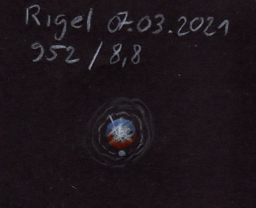
|
Jörg S. Schlimmer
Germany |
305mm (170x) |
high contrast |

|
|
|
★★★
|
theta 1 Ori, Trapezium, 41 Ori |
|
AB |
6m.5 |
7m.5 |
8.7" |
32° |
2021 |
Ori |
05h35m15.82s / -05°23'14.30" |
|
|
|
|
AC |
6m.5 |
5m.1 |
12.8" |
132° |
2021 |
|
|
|
|
|
|
AE |
6m.5 |
11m.1 |
4.4" |
354° |
2021 |
|
|
|
|
|
|
BD |
7m.5 |
6m.4 |
19.4" |
120° |
2019 |
|
|
|
|
|
|
CD |
5m.1 |
6m.4 |
13.4" |
62° |
2019 |
|
|
|
|
|
|
CF |
5m.1 |
11m.5 |
4.5" |
121° |
2021 |
|
|
Robert Zebahl
Leipzig (Germany) |
16x70 |
2021-02-24: Components A, C & D are clearly separable from each other. The fainter B component is almost completely outshone by A. The pair AB appears clearly elongated and is with concentrated observation in a few moments even visible separated. |
|
Robert Zebahl
Leipzig (Germany) |
70mm (22x) |
2021-02-24: The different bright components A-D are clearly visible separated from each other. |
|
Christopher Hay
Seeheim (Germany) |
71mm (32x) |
13x: CD definitely split, A uncertain, B not present.
18x: A, C and D definite, B uncertain.
32x: A, B, C and D present and clear.
Mediocre seeing but good transparency with strong M42 and an inkling of M43 at 32x. B is an eclipsing variable with a period of 6.5 days and an amplitude of 0.6mag, presumably obervation was at minimum, which would explain the difficulty in seeing it at lowest powers. C is the main source of excitation of the great Orion Nebula M42/43. |
|
René Merting
Drachhausen (Germany) |
76mm (190x) |
bei 29x und 57x sind die vier Komponenten A-D schön einzeln zu erkennen - für F braucht es 190x und ruhige Momente, dann ist die Komponente knapp abgesetzt südöstlich von C erkennbar - bei E (eigentlich leichter als F) wusste ich nicht, wo ich schauen sollte |
|
Winfried Kräling
Marburg (Germany) |
102mm (178x) |
|


|
Jörg S. Schlimmer
Germany |
127mm (108x) |
A-E split |
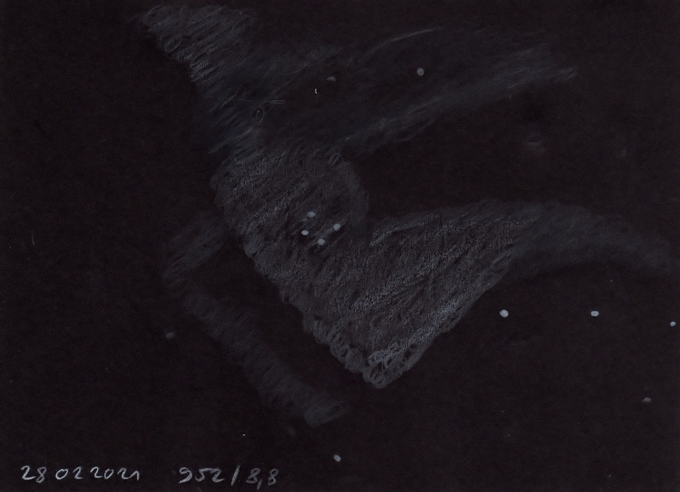
|
Jörg S. Schlimmer
Germany |
305mm (170x) |
A-F split |

|
|
|
★★★
|
sigma Ori, 48 Ori |
BU1032 |
AB |
4m.1 |
5m.3 |
0.3" |
70° |
2018 |
Ori |
05h38m44.77s / -02°36'00.20" |
|
|
|
STF762 |
AB-C |
3m.8 |
8m.8 |
11.4" |
239° |
2019 |
|
|
|
|
|
STF762 |
AB-D |
3m.8 |
6m.6 |
12.9" |
83° |
2019 |
|
|
|
|
|
STF762 |
AB-E |
3m.8 |
6m.3 |
41.4" |
62° |
2019 |
|
|
|
|
|
STF3135 |
AB-F |
3m.8 |
7m.9 |
208.0" |
324° |
2016 |
|
|
|
|
|
STF762 |
DC |
6m.6 |
8m.8 |
23.8" |
252° |
2019 |
|
|
|
|
|
STF762 |
EC |
6m.3 |
8m.8 |
52.9" |
241° |
2019 |
|
|
|
|
|
STF762 |
ED |
6m.3 |
6m.6 |
29.8" |
232° |
2019 |
|
|
Christopher Hay
Seeheim (Germany) |
10x42 |
Binoculars with internal stabilisation, handheld.
AB-D: No split, nor any elongation of AB towards D seen.
AB-E: E is set off well from AB but harder to split than the numbers would suggest. This is partly due to the major delta-mag, and partly to the circumstance that D effectively reduces the "free" stretch of sky to 29".
STF761 is a nice complement a few minutes of arc to the west and makes the visual impression of possibly belonging to the Sigma Ori complex, but Stelledoppie doesn't confirm this. |
|
René Merting
Drachhausen (Germany) |
12x42 |
AB-E: Komponente E ist nordöstlich abgesetzt von AB zu erkennen
AB-H: die relativ helle Komponente H steht in weitem Abstand im Südosten von AB |
|
Christopher Hay
Seeheim (Germany) |
15x45 |
Binoculars with internal stabilisation, handheld.
AB-D: No split acheived. However, focussing on AB feels uncertain, presumably due to disturbance by D. Also not split with 15x60 on tripod.
AB-E: E is set off well from AB. |
|
Christopher Hay
Seeheim (Germany) |
25x80 |
AB-D: D is set off nicely from AB and appears very slightly on the orange side, particularly in contrast to E. |
|
Christopher Hay
Seeheim (Germany) |
60mm (50x) |
AB-D: wide split, D is reddish. C not seen, perhaps seeing is too poor at time of observation. |
|
René Merting
Drachhausen (Germany) |
100mm (64x) |
AB-C: bei 64x zeigt sich Komponente C ganz schwach südwestlich von AB
AB-D: bei 32x schließt sich an die zartgelbe Komponente AB unmittelbar im Osten dicht stehend D weißorange an - ein schickes Trio zusammen mit E weiter östlich
AB-E: bei 32x zeigt sich in vierfacher Entfernung von AB-D die Komponente E weiter östlich in einer Linie - E ist ähnlich hell wie D |
|
Sarah Gebauer
Germany |
150mm (125x) |
ein sehr schönes Muster des Mehrfachsystems, auch wenn längst nicht alle Komponenten getrennt zu sehen waren, AB-C, AB-D und AB-E getrennt, A und B nicht |

|
Uwe Pilz
Leipzig (Germany) |
320mm (80x) |
AB-C-D schon im Aufsuchokular sichtbar. Sehr lebhafte Farben, einer der schönsten Mehrfachsterne überhaupt. Im selben Feld mit STF761 |

|
|
|
★★★
|
59 Ori |
H5 100 |
AB |
5m.9 |
10m.4 |
36.7" |
206° |
2015 |
Ori |
05h58m24.44s / +01°50'13.60" |
|
|
|
ARN37 |
AC |
5m.9 |
6m.9 |
177.8" |
293° |
2015 |
|
|
Christopher Hay
Seeheim (Germany) |
7x45 |
AC: Handheld: AC wide apart and immediately striking as double star.
On tripod: Wide apart but still very double-star-ish. C appears light blue.
Arnold 37 is a physical double at a distance to us of 364 light years. |
|
Christopher Hay
Seeheim (Germany) |
15x45 |
AC: AC wide apart but holding together visually as strong pair in 4.5° FOV. C distinctly blue, A appears slightly orange in contrast. |
|
Christopher Hay
Seeheim (Germany) |
42mm (12x) |
AC: AC makes very much a double-star impression despite the major separation. Western component slightly bluish, eastern component faintly orange. |
|
|
|
★★★
|
beta Mon, 11 Mon |
STF919 |
AB |
4m.6 |
5m.0 |
7.2" |
133° |
2021 |
Mon |
06h28m49.07s / -07°01'59.00" |
|
|
|
STF919 |
AC |
4m.6 |
5m.4 |
9.7" |
125° |
2021 |
|
|
|
|
|
BU570 |
AD |
4m.6 |
12m.1 |
26.5" |
56° |
2014 |
|
|
|
|
|
STF919 |
BC |
5m.0 |
5m.3 |
2.6" |
112° |
2021 |
|
|
René Merting
Drachhausen (Germany) |
18x70 |
Conditions in the target region: SQM-L 20.5
das Mehrfachsystem ist als 8 erkennbar, eine extrem knappe Berührung, wobei die Komponenten B und C im SO nur als ein Stern gesehen werden können - BC ist gleich hell wie A allein |
|
René Merting
Drachhausen (Germany) |
76mm (29x) |
Conditions in the target region: SQM-L 20.2
A-BC: bei 29x ein heller, knapp getrennter Doppelstern - BC im SO wirkt etwas heller als A
BC: bei 95x zeigen sich BC wie eine Ameise, noch berühren sich beide - bei 127x dann in ruhigen Momenten gelingt dir Trennung - sie haben fast den gleichen Positionswinkel wie A-BC - beide Komponenten B und C sind gleich hell und einzeln betrachtet jeweils etwa mehr als eine halbe Größenklasse schwächer als A |
|
René Merting
Drachhausen (Germany) |
100mm (32x) |
Conditions in the target region: SQM-L 20.5
A-BC: bei 32x ein wunderschöner eng stehender Doppelstern - die bei dieser Vergrößerung noch nicht trennbare Komponenten B und C im SO wirken leicht gelblich und ist leicht heller als A - die Komponenten A und BC wollen sich berühren, schaffen es aber nicht ;-)
BC: bei 64x wirkt BC leicht länglich wie ein Stäbchen - bei 107x dann der Aha-Effekt, es sind zwei Sterne, knapp getrennt und mit gleichem Positionswinkel wie A-BC - beide Komponenten B und C sind gleich hell und einzeln jeweils etwa eine halbe Größenklasse schwächer als A im NW |
|
Uwe Pilz
Leipzig (Germany) |
105mm (137x) |
Dreifachsystem, drei fast gleichhelle Sterne. Alle blau-weiß |

|
Sarah Gebauer
Germany |
254mm (96x) |
STF919 (AB): ein wirklich toller DS, zwei ganz schmale, leuchtstarke Pünktchen |
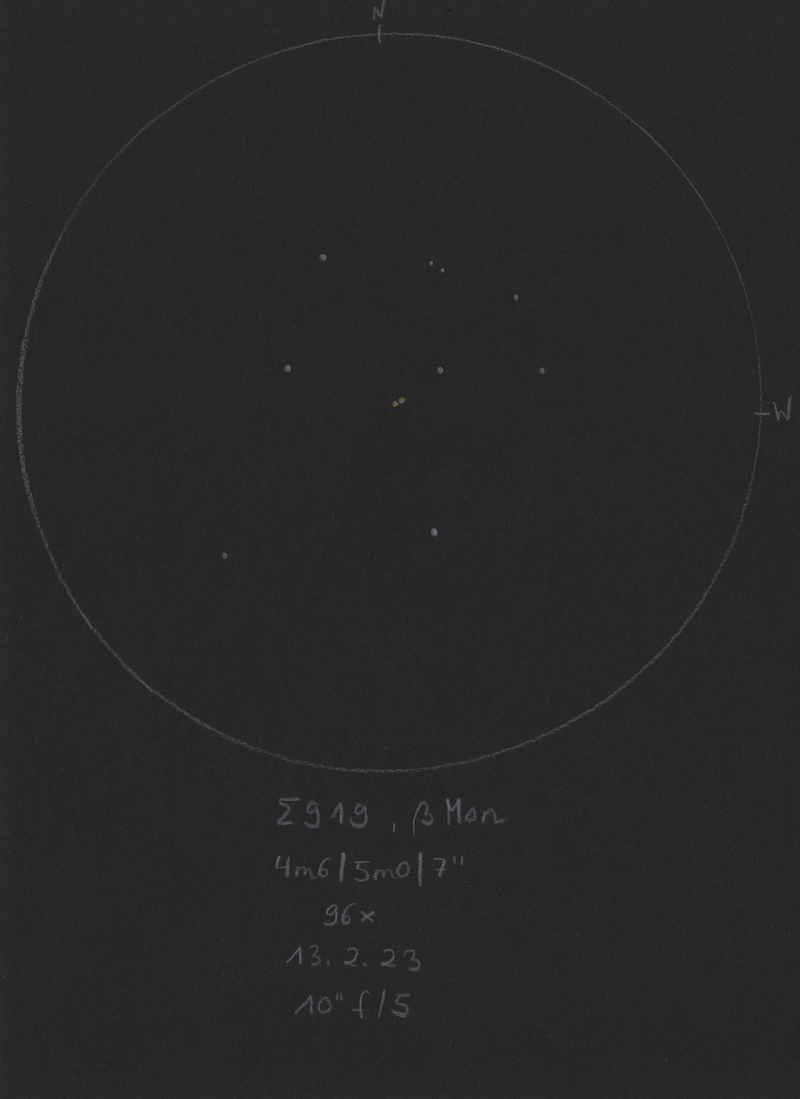
|
|
|
★★★
|
AGC1, 9 CMa, alpha CMa, Sirius |
|
AB |
-1m.5 |
8m.4 |
11.3" |
67° |
2021 |
CMa |
06h45m08.92s / -16°42'58.00" |
|
|
Robert Zebahl
Leipzig (Germany) |
102mm (86x) |
2023-02-14: In a steady phase, the companion is clearly visible within the halo of the primary component, but very faint. |
|
Uwe Pilz
Leipzig (Germany) |
105mm (198x) |
mit ADV, ohne nicht trennbar. Eindeutig |
|
Robert Zebahl
Leipzig (Germany) |
120mm (150x) |
2021-03-02: Used magnifications from 86x to 200x using a Baader yellow filter. The diffraction disk was relatively good visible, but the diffraction rings were noticeably in movement (Seeing 3/5). |
|
Jörg S. Schlimmer
Germany |
127mm (136x) |
not split |

|
Mark McCarthy
Fremont (California/USA) |
203mm (368x) |
Small disk formed on diffraction spike at correct separation and PA (Feb. 2016) |
|
Mark McCarthy
Fremont (California/USA) |
317mm (443x) |
A faint yellow-orange disk, to the edge of Sirius A's diffraction and just below my spider's diffraction spike. I let Sirius pass beyond the field stop, and for an instant there was Sirius B, clearly separated, before it too passed beyond the field stop. |
|
|
Jörg S. Schlimmer
Germany |
305mm |
hard to split with CMOS Camera |
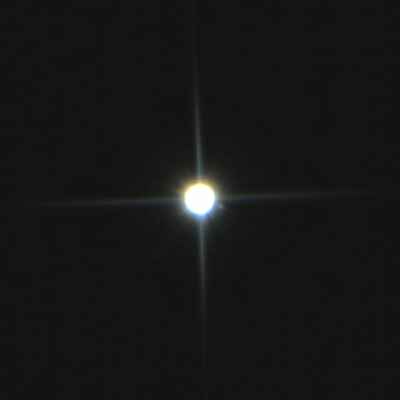
|
|
|
★★★
|
STF948, 12 Lyn |
|
AB |
5m.4 |
6m.0 |
1.9" |
65° |
2020 |
Lyn |
06h46m14.15s / +59°26'30.10" |
|
|
|
|
AC |
5m.4 |
7m.0 |
8.9" |
309° |
2019 |
|
|
|
|
Robert Zebahl
Leipzig (Germany) |
55mm (27x) |
AC: Components A/B and C well separated, but tight. Significant difference in brightness. The fainter C companion appeared slightly orange, the brighter one white-bluish. |
|
Robert Zebahl
Leipzig (Germany) |
55mm (167x) |
AB: Components A and B separated, whereby the Airy disks slightly overlap. The difference in brightness was well visible. |

|
Robert Zebahl
Leipzig (Germany) |
63mm (140x) |
AB: Components A and B split with almost no space in between. The difference in brightness was visible. |

|
Robert Zebahl
Leipzig (Germany) |
70mm (22x) |
AC: Well split, relatively close together with significant difference in brightness. |
|
Robert Zebahl
Leipzig (Germany) |
70mm (133x) |
AB: Both components A + B clearly split, whereby the diffraction rings where merged together. A very nice view together with component C. I sketched this triplet, which reflects my impression well. Unfortunately, the distance and position angle are not particularly well observed. Also the difference in brightness I didn't noticed during my observation. |

|
Robert Zebahl
Leipzig (Germany) |
102mm (129x) |
At 28x the pair AC is nicely separated without any problems. The close pair AB is already recognizable at 86x as a clear figure '8', at 125x wonderfully separated. The components A & B appear yellowish. Very nice view together with STF 946 in one field of view! |

|
Uwe Pilz
Leipzig (Germany) |
105mm (88x) |
im selben Feld mit STF 946 |

|
Robert Zebahl
Leipzig (Germany) |
152mm (129x) |
At 49x the pair AC is beautifully separated with a significant difference in brightness. At 100x, the close pair AB is also separated, although still very close together. A slight difference in brightness is noticeable. At 129x, the view is magnificent. The two bright components A & B present themselves yellowish, the fainter component C rather greyish. STF 948 can be well observed in a field of view with the neighbouring double star STF 946. Both show a nice overall scenery. |
|
Mark McCarthy
Fremont (California/USA) |
178mm (148x) |
AB: Gorgeous triple star, pale yellow A and B, and 1 delta blue C. really stunning. AB physical with a 733-year period |
|
|
|
★★★
|
ENG28 |
|
AB |
7m.9 |
7m.7 |
171.9" |
99° |
2015 |
Gem |
07h08m00.24s / +15°31'42.90" |
Christopher Hay
Seeheim (Germany) |
7x45 |
Handheld. Widely split matched pair. Easy to find half a degree south of 45 Gem. Comfortably viewed in 8.6° FOV together with STTA 80 AB and STF 1007, all three systems well-to-wide split, a charming trio of doubles. Alternatively, ENG 28 can also be viewed together with Zeta Gem (Mekbuda) 5° to the north.
Engelmann 28 is a physical double at a distance to us of 152 light years.
There is an interesting quirk about the ENG designation, on which Stelledoppie notes: Some time after publication of the IDS, the designation for Engelmann was changed from EN to ENG and that for Engelhardt from ENG to ENH. This has led to considerable confusion between the two. |
|
Mark McCarthy
Fremont (California/USA) |
80mm (13x) |
Pretty, wide equal finder split, white, nice field. |
|
|
|
★★★
|
STF1110, alpha Gem, 66 Gem, Castor |
|
AB |
1m.9 |
3m.0 |
5.4" |
53° |
2020 |
Gem |
07h34m35.86s / +31°53'17.80" |
|
|
|
|
AC |
1m.9 |
9m.8 |
71.6" |
164° |
2020 |
|
|
|
|
|
|
AD |
1m.9 |
10m.1 |
179.8" |
221° |
2017 |
|
|
|
|
Christopher Hay
Seeheim (Germany) |
20x60 |
AB: Handheld in reclining chair, binoculars with internal stabilisation. 16 April 2022 (5.5" angular distance according to database): Distinctly elongated, like a rectangle at the transition to a figure-8. |
|
Christopher Hay
Seeheim (Germany) |
26x42 |
AB: 13 May 2022 (5.5" angular distance according to database). Moon four-fifths full a few degrees north of Spica in Virgo. 70mm binoculars stopped down to 42mm aperture. Directly after looking the Moon I was able to split Castor AB definitely. Could hold this for a full minute, only then did the split start to become uncertain. Repeated the observation several times, found the split to be definite each time. |
|
Christopher Hay
Seeheim (Germany) |
32x70 |
AB: 13 March 2022 (5.5" angular distance according to database): Moon only 6° away and two-thirds full in the middle of Gemini. After concentrated observation of the Moon I slewed quickly to Castor to exploit the heightened acuity provided by viewing the bright Moon. Castor clearly split with fine black between A and B. After a while the split became more difficult but could still be held.
Followed this up with the same eyepiece previously used in the achromatic 70/400 binoculars now placed in 71/400 fluorite apochromatic telescope, thus again yielding 32x. Again A and B split after observation of the Moon, but harder to hold with the mono apochromat than with the bino achromat. |
|
Christopher Hay
Seeheim (Germany) |
36mm (33x) |
AB: 16 April 2022 (5.5" angular distance according to database): With Käsemann (KSM) polarising filter at 33x two kissing Airy disks which seem to move apart in good moments, but this is uncertain. Without filter at 33x just a squat figure-8 far removed from separation.
With polarising filter at 40x definite separation, fine first diffraction ring of component A. Without filter a stretched figure-8 with no separation.
At 50x clear and stable separation with and without filter. Best view at 66x, a ghostly pair in pitch-black FOV, the first diffraction rings of A and B merging, that of B very faint.
With a Baader Neodymium filter the positive effects are similar to those of the KSM polarising filter, but the clarity of separation is not quite as great as with the polarising filter. |
|
Robert Zebahl
Leipzig (Germany) |
55mm (27x) |
AB: At 27x slight difference in brightness visible. Double star appeared as '8'. At 38x clearly split, but tight. |
|
Robert Zebahl
Leipzig (Germany) |
63mm (26x) |
AB: Experiment to determine the smallest magnification to separate Castor. I observed on 2022-05-09, 2022-05-11 & 2022-05-18.
At 26x and 30x easily seen as a double star, but not clearly separable due to outshining. At 70x of course easily separated. Stopped down to 30mm aperture, Castor appeared partially separated at 26x, but very barely. The right viewing position at the eyepiece was important. At 30x with 30mm aperture, Castor was cleanly separated, but extremely tight.
Following a hint from Christopher Hay, I also used a red filter from Baader to avoid outshining at full aperture. Now also a separation at 26x was possible, whereby the components were extremely close to each other.
For me a magnification of 26x seems to be the minimum to separate Castor cleanly, if the brightness of the components is reduced sufficiently. |
|
Robert Zebahl
Leipzig (Germany) |
70mm (44x) |
AB: At 44x the double star appeared as an '8'. At 100x clearly split with noticeable difference in brightness. Both components appeared white. |
|
Axel Tute
Küssaberg (Germany) |
70mm (146x) |
AB: 11.03.2009: Separated with the 6mm Ortho and the 4.8mm Plössl. A: bluish B: orange |
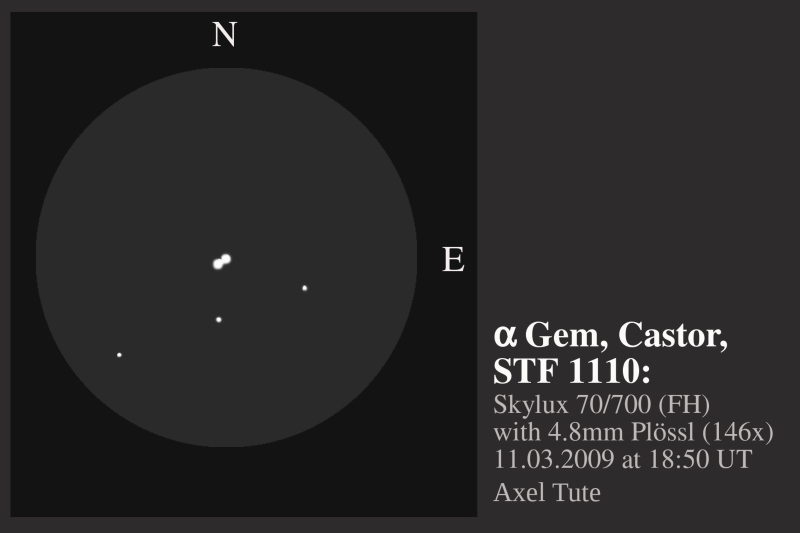
|
Axel Tute
Küssaberg (Germany) |
70mm (146x) |
AB: 23.03.2010: B with a clear gap. |
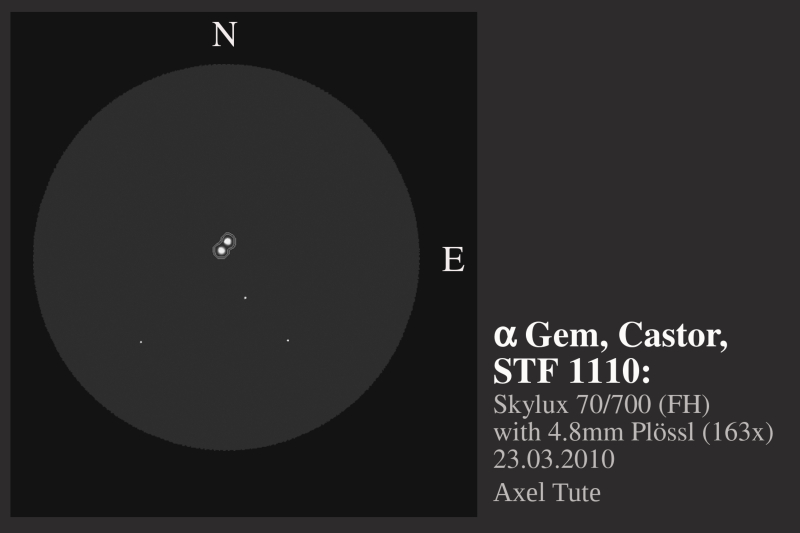
|
Christopher Hay
Seeheim (Germany) |
76mm (50x) |
AB: 18 February 2021: At 23x oval-elongated with clear position of component A. At 50x finely split. At 83x best sight with first diffraction rings slightly overlapping. At 100x nice pattern of the Airy disks and the overlapping first and second diffraction rings of both components. |
|
René Merting
Drachhausen (Germany) |
76mm (81x) |
AB: bei 57x sind zwei Murmeln erkennbar, die noch knappst aneinander kleben - bei 81x dann zeigen sich zwei helle Sterne knapp getrennt mit leichtem Farbkontrast, die A-Komponente im Süden schimmert leicht gelblich, B ist eine dreiviertel Magnitude schwächer und schön weiß |
|
René Merting
Drachhausen (Germany) |
100mm (107x) |
AB: bei 32x wirkt der Stern leicht länglich - bei 107x stehen die beiden Sterne schön eng mit überlagernden Beugungsscheibchen, die Komponenten sind dennoch getrennt erkennbar - Komponente B im Osten ist eine halbe Magnitude schwächer - ganz schwacher Farbkontrast |
|
Axel Tute
Küssaberg (Germany) |
100mm (163x) |
AB: 23.03.2010: Around A and B a diffraction ring each. Between the diffraction rings still a clear gap |

|
Uwe Pilz
Leipzig (Germany) |
105mm (144x) |
AB: blauweiß-weiß |

|
Winfried Kräling
Marburg (Germany) |
127mm (250x) |
AB: 13.03.2017: Beide Komponenten gelblich mit geringem Helligkeitsunterschied, bereits bei V=60x getrennt. |

|
Mark McCarthy
Fremont (California/USA) |
178mm (205x) |
AB: Castor. A is a very pale yellow and B is yellow-green, 2 delta mag, very bright, pretty wide, some fainter stars about. Physical with a 459.8-year period |
|
Christopher Hay
Seeheim (Germany) |
180mm (200x) |
AB: Two fat spotlights in space. Component B seems greenish at first sight (using a first-class reflector free of chromatic aberration), and certainly has a different hue than component A. The second diffraction rings of A and B meet. |
|
|
Frederik Wanink
Itterbeck (Germany) |
254mm |
AB |

|
Frederik Wanink
Itterbeck (Germany) |
254mm |
AB |
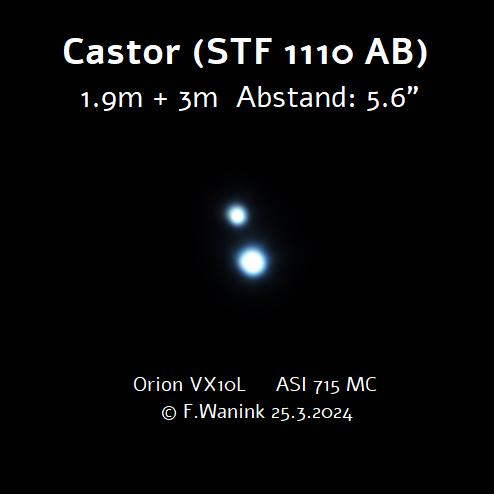
|
|
|
★★★
|
STTA89 |
|
|
6m.8 |
7m.7 |
76.6" |
84° |
2017 |
Gem |
07h51m00.20s / +31°36'48.70" |
Christopher Hay
Seeheim (Germany) |
7x45 |
Handheld. Clearly split. Primary distinctly brighter. Rather charming in 8.6° FOV together with Castor and Pollux, with which it forms an almost equilateral triangle.
A physical double at a distance to us of 660 light years. |
|
Christopher Hay
Seeheim (Germany) |
20x60 |
Handheld in reclining chair, binoculars with internal stabilisation. A charming wide pair with a subtle blue/orange colour contrast. |
|
Robert Zebahl
Leipzig (Germany) |
70mm (22x) |
At 22x widely separated with moderate difference in brightness. The primary component appeared whitish, at 44x rather white-yellowish. The companion appeared slightly orange. |
|
|
|
★★★
|
zeta Cnc, 16 Cnc |
STF1196 |
AB |
5m.3 |
6m.2 |
1.1" |
359° |
2021 |
Cnc |
08h12m12.79s / +17°38'51.20" |
|
|
|
STF1196 |
AB-C |
4m.9 |
5m.8 |
6.0" |
64° |
2020 |
|
|
|
|
|
STF1196 |
AC |
5m.3 |
5m.8 |
6.2" |
62° |
2020 |
|
|
|
|
|
HUT1 |
Ca-Cb |
6m.2 |
7m.1 |
0.3" |
344° |
2021 |
|
|
|
|
Robert Zebahl
Leipzig (Germany) |
70mm (133x) |
The wide pair AB-C is already separable at 22x. The pair AB shows at 133x two clearly overlapping diffraction disks with small difference in brightness, but without any notch. |

|
Christopher Hay
Seeheim (Germany) |
71mm (32x) |
AB-C: Finely split. AB yellowish. Substantial delta-mag. |
|
Robert Zebahl
Leipzig (Germany) |
102mm (86x) |
AB-C: Easy to separate. A: light grey, B: pale orange. |
|
Stefan Loibl
Rosenheim (Germany) |
102mm (164x) |
AB-C clearly split, AB obviously elongated but not split |
|
Uwe Pilz
Leipzig (Germany) |
105mm (288x) |
weißblau-gelb-gelb |

|
Robert Zebahl
Leipzig (Germany) |
120mm (67x) |
AB-C: Evident difference in brightness, easy to split. Both components of similar color. |
|
Robert Zebahl
Leipzig (Germany) |
120mm (200x) |
AB: Very tight. The Airy disks were still touching. Slight difference in brightness. Extremely beautiful triple star! |

|
Winfried Kräling
Marburg (Germany) |
127mm (250x) |
08.04.2018: Sehr schön, 3-fach Stern, A = weißgelb, B = weißgelb, C = weißgelb |

|
Sarah Gebauer
Germany |
150mm (83x) |
AB-C: bei 83x sind AB-C sauber getrennt, laut Atlas 2020 6,1'' Abstand, die Komponenten A und B mit 1,1'' lassen sich nicht trennen, viele schöne Feldsterne dabei |

|
Christopher Hay
Seeheim (Germany) |
180mm (200x) |
AB: Hair-fine split. A and B both yellowish-white. C wide from AB, bluish-white, nice colour contrast to AB. |
|
Mark McCarthy
Fremont (California/USA) |
317mm (553x) |
Ca-Cb: not quite round, oval/olive shaped. It is the AB-C of STF 1196. |
|
Mark McCarthy
Fremont (California/USA) |
317mm (553x) |
AB: Triple, all near equal magnitude, yellow-white. AB ~0.8", hair split. |
|
Mark McCarthy
Fremont (California/USA) |
317mm (553x) |
AC: Triple, all near equal magnitude, yellow-white. AC ~6", wide split. |
|
Karsten Kopp
Köln (Germany) |
600mm (257x) |
AB: Die Komponenten AB-C bei etwas größerem Helligkeitsunterschied einfach zu trennen und auch schön anzusehen. Sterne erstrahlen weißlich gelb. Komponente AB war nicht zu trennen. |
|
|
Frederik Wanink
Itterbeck (Germany) |
254mm |
AB-C |

|
|
|
★★★
|
11 Hya, epsilon Hya |
SP1 |
AB |
3m.5 |
5m.0 |
0.1" |
324° |
2021 |
Hya |
08h46m46.51s / +06°25'07.70" |
|
|
|
STF1273 |
AB-C |
3m.5 |
6m.7 |
2.9" |
311° |
2020 |
|
|
|
|
|
STF1273 |
AB-D |
3m.5 |
12m.5 |
18.1" |
201° |
2017 |
|
|
|
|
|
STF1273 |
AB-E |
3m.5 |
10m.8 |
340.5" |
2° |
2015 |
|
|
|
|
|
STF1273 |
AB-F |
3m.5 |
10m.4 |
406.5" |
265° |
2015 |
|
|
|
|
Robert Zebahl
Leipzig (Germany) |
70mm (133x) |
AB-C: Not split. Although a slight brightening was visible in the first diffraction ring, it could also have come from slight coma of the refractor. |
|
Sarah Gebauer
Germany |
100mm (200x) |
AB-C: ist ein heller Stern vom Hydra-Kopf, nicht zu trennen, vermutlich, weil die Komponente AB zu hell strahlt |
|
Robert Zebahl
Leipzig (Germany) |
102mm (160x) |
AB-C: 2020-03-27: The much fainter companion is well visible as an almost round knot directly at the diffraction ring of the primary component. Very nice sight. The seeing was mediocre (3/5). |
|
Uwe Pilz
Leipzig (Germany) |
105mm (200x) |
AB-C: bei 144x schwierig |
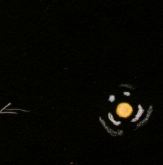
|
Robert Zebahl
Leipzig (Germany) |
152mm (150x) |
AB-C: 2020-03-27: The companion is immediately visible as a tiny star close to the primary component. Due to the chromatic aberration of the achromat, there is a slight tendency to outshine. Nevertheless a nice view. The seeing was mediocre (3/5). |
|
Mark McCarthy
Fremont (California/USA) |
508mm (533x) |
AB-C: Epsilon Hya A is bright orange-yellow, B is much fainter and a little blue, ~3". [SP 1 AB is 3.49/5.00 0.2" not seen] |
|
|
|
★★★
|
SHJ107, 6 Leo |
|
|
5m.2 |
9m.3 |
37.1" |
77° |
2018 |
Leo |
09h31m57.58s / +09°42'56.80" |
René Merting
Drachhausen (Germany) |
10x32 |
B ist ganz schwach westlich von A erkennbar, ein bisschen mehr als knapp abgesetzt - mitunter ist das Erkennen von B ein Geduldsspiel |
|
René Merting
Drachhausen (Germany) |
12x42 |
Komponente B ist sehr schwach und zeigt sich östlich von A ordentlich abgesetzt - ein sehr ungleiches Paar, A ist sehr hell und strahlt warmweiß bis gelbweiß |
|
René Merting
Drachhausen (Germany) |
18x70 |
auch 6 Leo - die A-Komponente strahlt sehr auffällig in einem hellen Gelb, B zeigt sich ganz schwach ost-nordöstlich - Trennung ordentlich - Helligkeitsunterschied nicht abschätzbar |
|
Sarah Gebauer
Germany |
100mm (49x) |
in Aufsuchvergrößerung zeigt der Stern ein schönes Kupferorange, der Begleiter ist extremst schwach dagegen, aber getrennt östlich bei genauem Hinsehen zu erkennen - bei 49-fach ist die Trennung dann weit - die Hauptkomponente bleibt wunderschön Goldorange, der deutlich schwächere Begleiter kommt kaum über einen mausgrauen Farbeindruck hinaus - ein wunderschönes Paar durch die Ungleichheit der Komponenten |
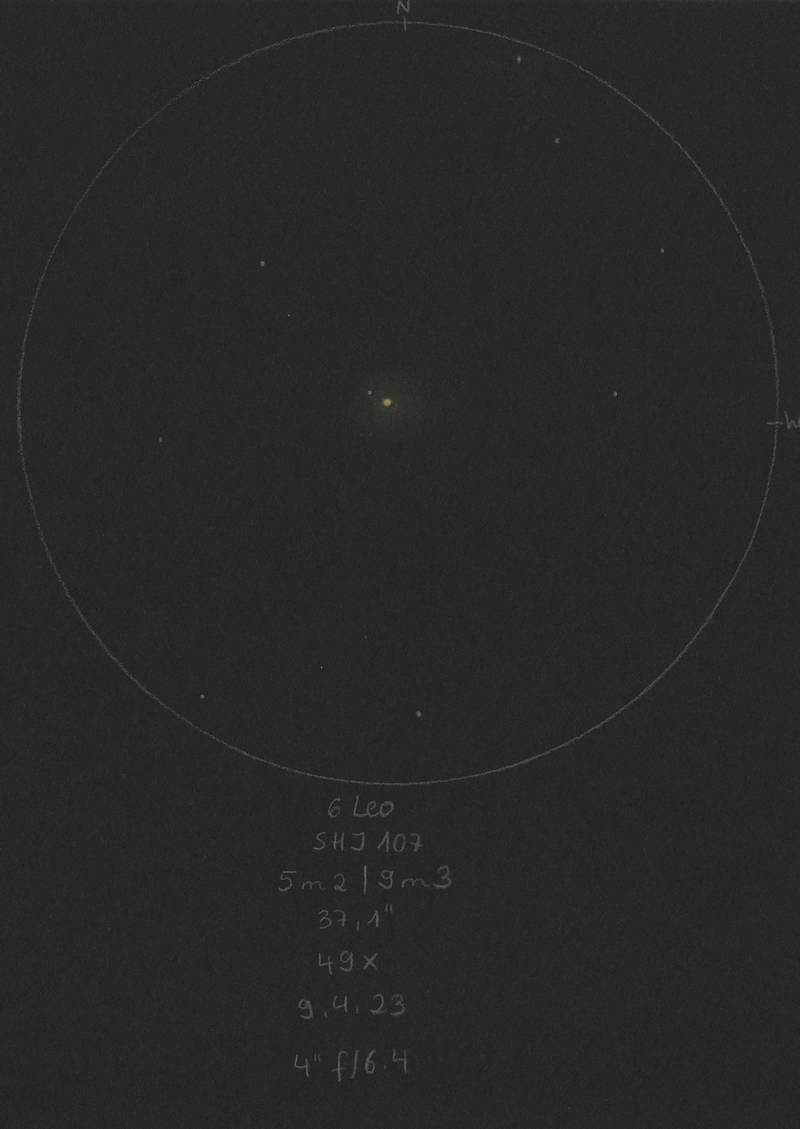
|
Axel Tute
Küssaberg (Germany) |
200mm (80x) |
16.03.2009: Simple with the C8: A is orange. B is bluish. Beautiful colours. |

|
Mark McCarthy
Fremont (California/USA) |
317mm (553x) |
A star is light orange & 3 delta mag to B star which is a white, well separated point |
|
|
|
★★★
|
STF1552, 90 Leo |
|
AB |
6m.3 |
7m.3 |
3.1" |
209° |
2018 |
Leo |
11h34m42.50s / +16°47'48.90" |
|
|
|
|
AC |
6m.3 |
9m.8 |
63.4" |
235° |
2018 |
|
|
Robert Zebahl
Leipzig (Germany) |
55mm (42x) |
AB: A and B very tight and unequal. Much fainter component C very wide apart. All components almost in line. Very nice view. |

|
Axel Tute
Küssaberg (Germany) |
70mm (117x) |
AB: 07.03.2009: Separation requires 117x. A & B are white. |
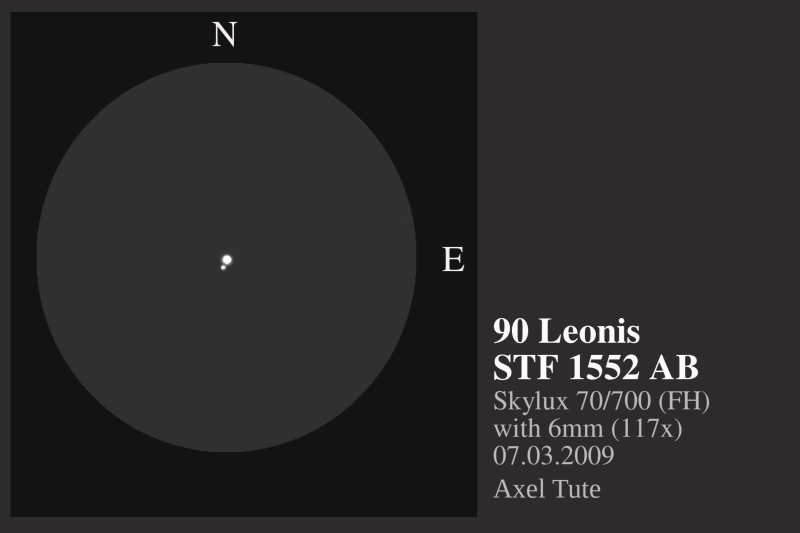
|
Sarah Gebauer
Germany |
100mm (136x) |
lange Zeit nach der ersten Beobachtung nun auch die Komponenten A und B getrennt, was bei 136x gut gelingt |
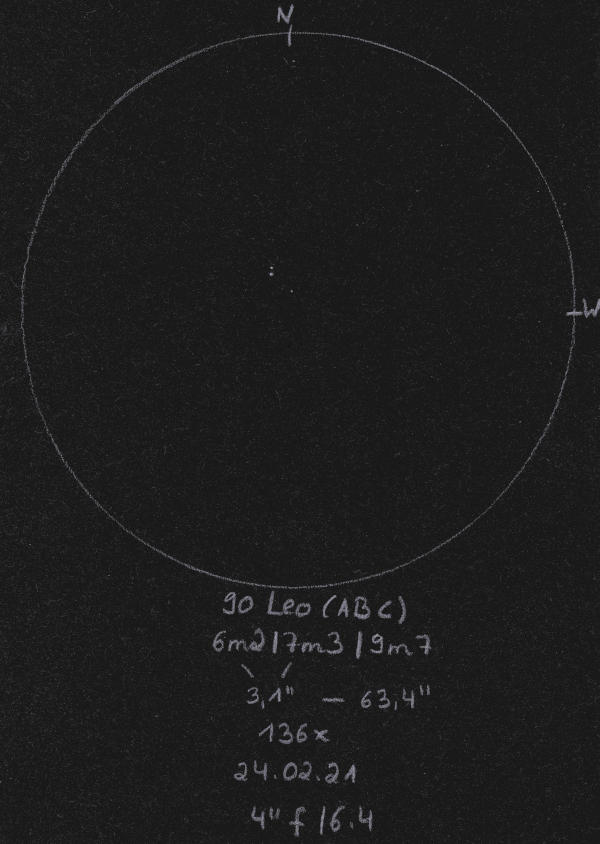
|
René Merting
Drachhausen (Germany) |
100mm (142x) |
AB: bei 64x wirken die Komponenten A und B wie eine 8 - bei 142x dann die Gewissheit, B ist jetzt allein erkennbar, vom Positionswinkel südwestlich, aber etwas südlicher als C - Helligkeitsunterschied eine dreiviertel Größenklasse - B wirkt hellorange gegen die weiße Komponente A
AC: bei 32x ist Komponente C ziemlich weit südwestlich von A erkennbar - Helligkeitsunterschied mindestens 2.5 Größenklassen |
|
Uwe Pilz
Leipzig (Germany) |
105mm (88x) |
bläulich und violett |

|
Sarah Gebauer
Germany |
150mm (30x) |
AB: einfach zu trennen, erst bei 83x, dann auch bei 30x, sehr feine Punkte mit sichtbarem Helligkeitsunterschied |
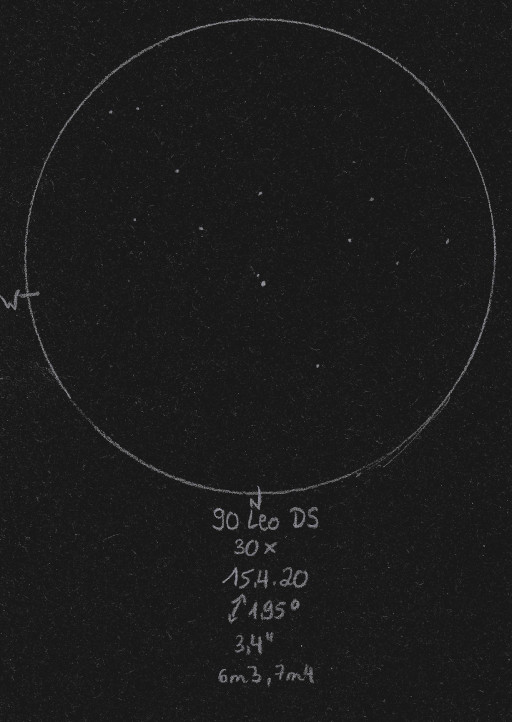
|
Axel Tute
Küssaberg (Germany) |
200mm (167x) |
18.05.2007: Simple with the C8 at 167x. No colours |

|
Mark McCarthy
Fremont (California/USA) |
317mm (170x) |
AB: 90 Leonis, a close but easily split pair at 170x, a yellow-white A and a bluish-white B. |
|
Mark McCarthy
Fremont (California/USA) |
508mm (333x) |
AB: 90 Leo. Blazing white pair, ~1 delta mag, ~3" |
|
|
|
★★★
|
SHJ146 |
|
AB |
7m.7 |
8m.7 |
49.5" |
290° |
2017 |
Vir |
12h31m14.61s / +01°19'37.00" |
René Merting
Drachhausen (Germany) |
15x56 |
beide Sterne zeigen sich mit ordentlich Abstand - Komponente A im Osten ist weiß und B ist gut 1.5 Magnituden schwächer und kommt über den graue Maus-Status nicht hinaus |
|
René Merting
Drachhausen (Germany) |
18x70 |
Komponente B ist westlich von A erkennbar - Helligkeitsunterschied 1.5 Magnituden - A weiß, B grau - das Sternpaar fällt auf, weil kaum gleichhelle Sterne in der Umgebung stehen |
|
Robert Zebahl
Leipzig (Germany) |
70mm (33x) |
Visible difference in brightness and color. I couldn't precisely define the colors itself, but A appeared rather orange, B rather bluish. |
|
Robert Zebahl
Leipzig (Germany) |
102mm (28x) |
Pretty wide pair with visible difference in brightness and lovely color contrast. A: pale orange, B: light blue. |
|
|
|
★★★
|
STF1670, gamma Vir, 29 Vir, Porrima |
|
AB |
3m.5 |
3m.5 |
2.9" |
356° |
2021 |
Vir |
12h41m39.60s / -01°26'57.90" |
|
|
Christopher Hay
Seeheim (Germany) |
15x60 |
28 February 2021 at 3" separation: Very slight elongation. PA estimated at 5° (thus only 9° off, which seems fairly precise to me considering the low power of 15x and the minimal elongation, both of which make PA estimation difficult).
Intentionally flashed the eyes on the almost full Moon directly prior to observation in order to enhance acuity. Compared the sight of Porrima repeatedly with that of similarly bright Epsilon Vir (Vindemiatrix) to check whether the elongation is perhaps an artefact of the bincolulars or of my eyes, but no elongation seen there. |
|
Robert Zebahl
Leipzig (Germany) |
16x70 |
2021-05-23: Not even close to appear as a double star. The components are just too bright, the separation too small. |
|
Robert Zebahl
Leipzig (Germany) |
55mm (56x) |
2019-05-18: At 38x slightly elongated. At 56x touching diffraction disks. At 71x clearly separated with very small gap. |
|
Robert Zebahl
Leipzig (Germany) |
70mm (44x) |
2021-05-26: At full aperture Porrima appears almost separated at 44x. The two diffraction disks are well visible. At 31x it is difficult to see any elongation at all.
At 40mm aperture Porrima can be seen clearly elongated already at 31x, from 67x it appears as an '8'. At only 22x Porrima is not visible as a double star. |
|
Robert Zebahl
Leipzig (Germany) |
70mm (104x) |
2019-05-04: At 47x clearly visible as '8', at 73x split with almost touching diffraction disks. At 104x clearly separated, equally bright and pretty close together. The gap was smaller than the diameter of the diffraction disk. |
|
Mark McCarthy
Fremont (California/USA) |
80mm (92x) |
Porrima. Nice and easy, yellow-white equal stars. 169-year period |
|
Robert Zebahl
Leipzig (Germany) |
102mm (125x) |
2019-05-01: Extremely nice double star! Equally bright and relatively close together. Both components appeared yellowish-white. |
|
Uwe Pilz
Leipzig (Germany) |
105mm (200x) |
weiß-weiß, die nördliche Komponente ist eine Winzigkeit heller |
|
Winfried Kräling
Marburg (Germany) |
127mm (146x) |
21.04.2018: Bei V=100x erscheint dieser orangefarbene Doppelstern bereits als „8“. Bei V=146x ist Porrima voll getrennt. |

|
Sarah Gebauer
Germany |
150mm (166x) |
die 2,8'' entfernten Komponenten A und B konnten haarscharf bei 83x und 166x getrennt werden, beide strahlen gleich hell als ganz dichte Glanzpünktchen; Komponenten E und F wurden gesehen, C und D allerdings nicht; bei 83x waren AB ganz knapp nicht mehr voneinander getrennt |
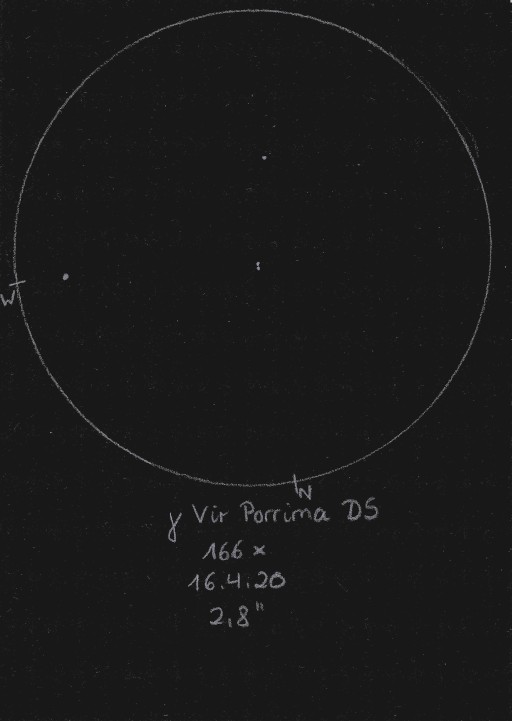
|
Mark McCarthy
Fremont (California/USA) |
178mm (205x) |
Porrima. Bright near equal, dull white, well split about 4". Physical with a 169-year period, I missed my chance to witness the rapid periastron a few years ago |
|
Mark McCarthy
Fremont (California/USA) |
317mm (170x) |
Porrima. Very pretty yellow-white, near equal, close split at 170x. Star disks improved with apodizing mask. |
|
|
|
★★★
|
STF1694 |
|
AB |
5m.3 |
5m.7 |
21.8" |
324° |
2017 |
Cam |
12h49m13.80s / +83°24'46.30" |
Christopher Hay
Seeheim (Germany) |
7x45 |
Handheld. Very elongated with absolutely clear PA, but hand tremor prevents separation. |
|
Christopher Hay
Seeheim (Germany) |
7x50 |
On tripod. Split with a sliver of black inbetween, with creamy-white components, attractive sight. Dry-frozen night in January, 47° elevation above horizon. |
|
Christopher Hay
Seeheim (Germany) |
10x42 |
Binoculars with internal stabilisation, handheld. Fine split with definite difference in brightness of components. |
|
Christopher Hay
Seeheim (Germany) |
15x45 |
Binoculars with internal stabilisation, handheld. AB cleanly split with distinct difference in magnitudes. Strong visual presence of this physical double is enhanced by the complete lack of visual competition in 4.5° FOV. Interesting to contemplate that in the 9th century AD Struve 1694 was just as close to the celestial north pole as Polaris (also a physical double) is today. Also known as 32H Cam, which comes from the celestial map produced by Johannes Hevelius in the late 17th century. |
|
Christopher Hay
Seeheim (Germany) |
25x80 |
Well apart but by no means falling apart, and totally dominating the 3.2° field of view. Neither component would appear particularly colourful on its own, but viewed together the primary is definitely more on the orange side and the secondary more bluish.
At 25x in 3.2° FOV and with an exit pupil around 3mm making the sky background pitch-black, STF 1694 has such a strong visual impact that it becomes a showpiece specimen of a double star. Three-star rating awarded because of this strong visual presence plus binocular accessibility (see 7x50 observation) plus true physical nature of the double (according to Stelledoppie) plus pole-star role in the Middle Ages. |
|
Christopher Hay
Seeheim (Germany) |
36mm (8x) |
Split clearly, so clearly that I stumble across the pair while panning through the area. Primary seems yellowish, an impression confirmed by observation directly afterwards with 71mm refractor at 32x, in which the primary is distinctly yellowish and the pair visually very strong. |
|
Robert Zebahl
Leipzig (Germany) |
70mm (15x) |
2017-12-21: Easy to split with noticeable angular distance and slight difference in brightness. The faint component tends to be more bluish, the brighter one appeared more light yellowish. |
|
René Merting
Drachhausen (Germany) |
100mm (32x) |
bei 32x strahlen beide Komponenten richtig hell und gut getrennt - leichter Farbkontrast, Komponente A ist leicht gelblich, B wirkt eher unterkühlt |
|
Robert Zebahl
Leipzig (Germany) |
152mm (30x) |
2022-10-25: Easily separable, bright and very dominant in the field. The difference in brightness is small. Due to the brightness, both components shine in brilliant colors: light yellow & white-bluish. |
|
|
|
★★★
|
STF1785 |
|
|
7m.4 |
8m.2 |
2.7" |
193° |
2021 |
Boo |
13h49m04.00s / +26°58'47.70" |
|
|
Christopher Hay
Seeheim (Germany) |
71mm (67x) |
4 June 2023. Hairfine split. Primary yellowish. Secondary seems duller, towards red.
Pair is slowly closing. Perhaps no longer accessible at 67x ten years from now. |
|
Sarah Gebauer
Germany |
100mm (49x) |
der angeblich Farbe zeigende DS ist bei 80x getrennt – zwei nahezu gleich helle Murmelchen, die ganz klein und dicht beieinander stehen – bei 50x zeigen die nun nicht mehr getrennten, aber länglichen Sterne einen leicht warmgelben Farbton, leicht ins Hellorange gehende |
|
Mark McCarthy
Fremont (California/USA) |
203mm (333x) |
Slightly orange-tinged white stars, near equal, well separated |
|
Christopher Hay
Seeheim (Germany) |
280mm (110x) |
4 June 2023. At 110x well split. Primary a clear, mild, cold yellow. Secondary hard to determine in colour.
At 180x primary retains its yellow and secondary exhibits a mild tangerine-orange.
A charming pair made all the more interesting by its true physical nature, with the secondary orbiting the primary every 156 years. Fairly easy to find 2° SW of globular Messier 3. |
|
Karsten Kopp
Köln (Germany) |
600mm (180x) |
Im CLT bei 180 x Vergrößerung gut zu trennen. Leichter Helligkeitsunterschied und beider Sterne erscheinen gelborange. |
|
|
|
★★★
|
S656 |
|
|
6m.9 |
7m.4 |
86.2" |
209° |
2018 |
Boo |
13h50m23.51s / +21°16'35.80" |
Christopher Hay
Seeheim (Germany) |
7x50 |
On tripod. Well split. A compact pair directly next to orangish-yellow 6 Boo in a remarkably attractive 7.3° FOV together with widely separated 1 Boo (STF 1772 AD) two degrees southwest plus Eta and Tau Boo about three degrees south.
A physical double at a distance to us of 345 light years. This means that South 656 is not just close to 1 Boo AD in our perspective but also actually in space, making the two pairs one of the finest physical double-doubles in the sky for 7x binoculars. |
|
Robert Zebahl
Leipzig (Germany) |
8x40 |
2020-04-05: Wide, medium bright pair. Primary component appeared slightly orange, the companion greyish. The double star is in close vicinity to the star 6 Boo, which shines in a pale orange. |
|
Christopher Hay
Seeheim (Germany) |
15x60 |
On tripod. Wide split. Primary orangish. Well-matched pair, very striking. Nicely accentuated by yellowish 6 Boo a few arc-minutes to the west. |
|
Christopher Hay
Seeheim (Germany) |
30mm (6x) |
While panning towards globular M3 I stumble across this striking pair in the finder, very even and well split. |
|
Robert Zebahl
Leipzig (Germany) |
70mm (22x) |
2020-04-24: Widely separated with little difference in brightness. Both components appeared slightly yellowish. Standing close to 6 Boo, which also shines in a slight yellow. |
|
Mark McCarthy
Fremont (California/USA) |
178mm (205x) |
Wide, white, half delta. WDS says it's physical but I calculate no parallax overlap and the two are too far apart to be gravitationally bound |
|
Christopher Hay
Seeheim (Germany) |
254mm (100x) |
At this power very wide, slight delta mag. At first sight no evident colour contrast, but after a while it becomes increasingly clear that the secondary is bluer than the primary. This effect is rather charming. |
|
|
|
★★★
|
alpha Lib, Zubenelgenubi, Kiffa Australis, Lanx Australis |
SHJ186 |
AB |
2m.7 |
5m.2 |
231.1" |
314° |
2012 |
Lib |
14h50m52.78s / -16°02'29.80" |
|
|
|
AOT53 |
AC |
2m.7 |
12m.5 |
275.6" |
291° |
2000 |
|
|
|
|
Christopher Hay
Seeheim (Germany) |
naked eye |
AB: Noticed with naked eye and without prior PA knowledge that a secondary was flickering next to Zubenelgenubi. Unexpected and first naked-eye sighting. Checked position with binoculars to be sure. Further naked-eye look at Mizar/Alkor (Zeta UMa) to gauge my momentary acuity and assess the difference to Alpha Lib. Zeta UMa more easily and widely split than ever before, and Alkor appeared for the first time bluish, so this was an exceptional night for naked-eye double-star splitting. Three-star rating awarded because Zubenelgenubi is the second-best naked-eye true-physical double star in the summer sky after Mizar/Alkor. |
|
René Merting
Drachhausen (Germany) |
8x25 |
AB: ein schöner Fernglas-Doppelstern mit leichtem Farbkontrast - beide Sterne stehen weit auseinander - B im Nordwesten wirkt braungrau gegen die warmweiße A-Komponente - Helligkeitsunterschied eine Größenklasse (total verschätzt, es sind 2.45 mag) |
|
Christopher Hay
Seeheim (Germany) |
10x56 |
AB: Handheld. A strong, wide pair. Both cold white, the secondary more bluish than the primary.
Delightful in 6.3° FOV together with the "Zub's Hat" (Hay-Merting 9) asterism directly above (north of) the pair, an array of six stars looking very much like a hat or cap on Zubenelgenubi. |
|
Gerd Kohler
Langenzenn (Germany) |
254mm (76x) |
AB: Bläulich-weiß - leicht bläulich. |
|
Gerd Kohler
Langenzenn (Germany) |
254mm (76x) |
AC: Bläulich-weiß - weiß. Sehr schwacher Begleiter. |
|
|
|
★★★
|
mu Boo, 51 Boo, Alkalurops |
CHR181, mu 1 Boo |
Aa-Ab |
4m.3 |
|
0.1" |
188° |
2012 |
Boo |
15h24m29.54s / +37°22'37.10" |
|
|
|
STFA28, mu 1 Boo |
AB |
4m.3 |
7m.1 |
109.2" |
171° |
2020 |
|
|
|
|
|
STF1938, mu 2 Boo |
Ba-Bb |
7m.1 |
7m.6 |
2.2" |
2° |
2020 |
|
|
|
|
Christopher Hay
Seeheim (Germany) |
7x45 |
STFA28 (AB): Handheld. Wide split. A compact uneven pair. Component A is bluish-white.
Rather charming in 8.6° FOV with Nu1/2 Boo, which has a gorgeous colour contrast, golden-orange and ice-blue, making it one of the strongest colour-contrast pairs in the sky for binoculars and greatly accentuating the sight of Mu Boo.
In 15x45 binoculars STFA28 AB is very wide, component A bluish-white, B warmer. |
|
Robert Zebahl
Leipzig (Germany) |
8x40 |
STFA28 (AB): Easily split with obvious difference in brightness. |
|
Robert Zebahl
Leipzig (Germany) |
16x70 |
STFA28 (AB): 2021-06-14: Wide, relatively striking pair. Pale yellow & dark orange. |
|
René Merting
Drachhausen (Germany) |
16x70 |
STFA28 (AB): weit getrenntes Pärchen, aufgrund der großen Helligkeitsunterschiedes schöner Farbkontrast - Komponente A im Norden gelblich, B im Süden mehr grau-braun |
|
Robert Zebahl
Leipzig (Germany) |
70mm (22x) |
STFA28 (AB): Evident, very wide apart and unequal. A: white-yellowish, B: grey. |
|
Mark McCarthy
Fremont (California/USA) |
80mm (94x) |
STFA28 (AB): Alkalurops Bright yellow-white A and bluish B, which is itself a slightly unequal close double, finely split (STF 1938 Ba,Bb) -- 256.5-year period, now coming off apastron |
|
Sarah Gebauer
Germany |
100mm (21x) |
STFA28 (AB): 02.10.23: bei 21-fach sehr eindeutig auszumachen, das Paar sticht durch eine sehr helle, blass zitronengelbe A-Komponente und eine graue bis schmutzig weiße, weit abgesetzte B-Komponente hervor |

|
Sarah Gebauer
Germany |
100mm (49x) |
STFA28 (AB): bei 49-fach sehr hell und sehr weit, unterschiedlich hell und dominiert das ohnehin schon eher leere Gesichtsfeld |
|
Robert Zebahl
Leipzig (Germany) |
102mm (125x) |
Beautiful view! This triple system includes STFA 28 and STF 1938. |
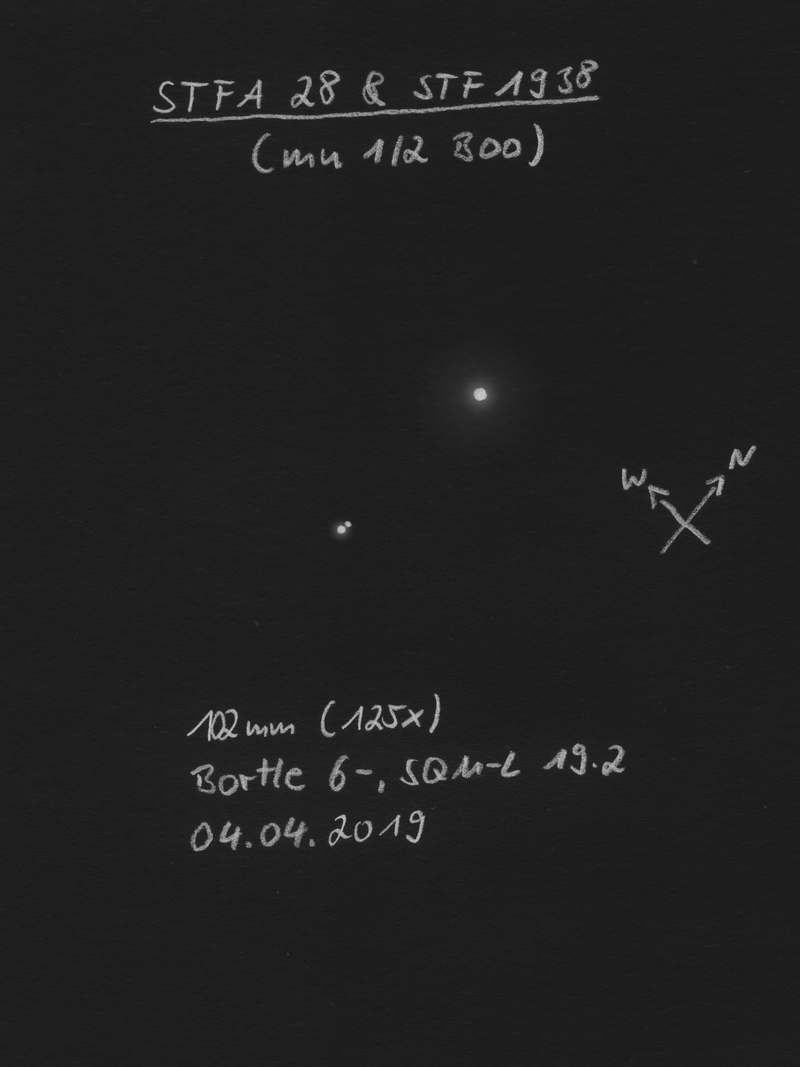
|
Uwe Pilz
Leipzig (Germany) |
105mm (288x) |
ein heller 4m und zwei nahe dunkle 7m, lohnend. |
|
René Merting
Drachhausen (Germany) |
107mm (30x) |
STFA28 (AB): AB: das Paar ist bei 30x komfortabel getrennt erkennbar, A strahlt leicht gelblich - Komponente B besteht aus zwei Sternen Ba, Bb (STF 1938), die ab 120x getrennt zu sehen sind - Bb im Norden ist gut eine viertel bis halbe Größenklasse schwächer als Ba |
|
René Merting
Drachhausen (Germany) |
107mm (120x) |
STF1938 (Ba-Bb): bei 86x ist nördlich von Ba ein zweiter etwas schwächerer Stern erkennbar, er klebt noch an Ba - 120x reichen dann für eine knappe Trennung - Bb im Norden ist eine viertel bis halbe Größenklasse schwächer |
|
Robert Zebahl
Leipzig (Germany) |
120mm (23x) |
STFA28 (AB): Easy to split with large angular distance and noticeable difference in brightness. |
|
Sarah Gebauer
Germany |
150mm (125x) |
A-BC mit 109'' sind bei 125x sehr weit getrennt, es ist der Ansatz eines engen Doppelsterns zu erkennen, der sich mit 2,2'' Abstand auch bis 250x nicht auftrennen ließ |
|
Christopher Hay
Seeheim (Germany) |
180mm (105x) |
STF1938 (Ba-Bb): At 105x in poor seeing a kissing, evenly matched pair. At 180x clearly split despite the poor seeing, southern component (Ba) seems slightly brighter than Bb. |
|
Mark McCarthy
Fremont (California/USA) |
203mm (205x) |
STFA28 (AB): Bright A star does not seem round. The B star is a tight equal pair, pretty set. [Aa,Ab is CHR 181 0.1", and I'd be shocked if I actually detected it. STFA 28 is technically the bright star and the tight pair, the tight pair is Ba,Bb = STF 1938, 7.09/7.63, 2.2"] |
|
Mark McCarthy
Fremont (California/USA) |
203mm (205x) |
STFA28 (AB): Bright A star does not seem round (CHR181). B star is a tight equal pair (STF1938 Ba-Bb). Pretty set. STFA 28 is technically the bright star and the tight pair |
|
Mark McCarthy
Fremont (California/USA) |
203mm (205x) |
CHR181 (Aa-Ab): Bright A star does not seem round (CHR181). B star is a tight equal pair (STF1938 Ba-Bb). Pretty set. STFA 28 is technically the bright star and the tight pair |
|
Mark McCarthy
Fremont (California/USA) |
203mm (205x) |
STF1938 (Ba-Bb): Bright A star does not seem round (CHR181). B star is a tight equal pair (STF1938 Ba-Bb). Pretty set. STFA 28 is technically the bright star and the tight pair |
|
Frederik Wanink
Itterbeck (Germany) |
254mm (640x) |
STF1938 (Ba-Bb): 3er System, schön |

|
Mark McCarthy
Fremont (California/USA) |
317mm (277x) |
STFA28 (AB): Bright white star with tight yellow pair STF 1938 as its companion. |
|
Mark McCarthy
Fremont (California/USA) |
317mm (553x) |
STFA28 (AB): Striking. Bright star with near equal double STF 1938 paired with it. A star is a spectroscopic binary |
|
Mark McCarthy
Fremont (California/USA) |
317mm (553x) |
STF1938 (Ba-Bb): Near equal close but well split double also paired with STFA28 |
|
Karsten Kopp
Köln (Germany) |
600mm (257x) |
Hier handelt es sich um ein Dreifachsternsystem, welches jetzt aber nicht durch eine besondere Färbung der Sterne auffällt. Die A - B/C Komponenten stehen noch sehr weit auseinander, wobei auch die A-Komponente um einiges heller erscheint. Die beiden Komponenten B/C sind wesentlich näher beieinander und unterscheiden sich auch kaum in ihrer Helligkeit. |

|
|
|
★★★
|
rho Oph, 5 Oph |
H2 19 |
AB |
5m.1 |
5m.7 |
3.0" |
335° |
2021 |
Oph |
16h25m35.03s / -23°26'47.00" |
|
|
|
H2 19 |
AC |
5m.1 |
7m.3 |
151.1" |
0° |
2021 |
|
|
|
|
|
H2 19 |
AD |
5m.1 |
6m.8 |
156.1" |
253° |
2021 |
|
|
|
|
|
KOU63 |
CF |
5m.8 |
11m.7 |
4.8" |
206° |
2000 |
|
|
|
|
|
BU1115 |
DE |
6m.8 |
8m.4 |
0.3" |
196° |
2018 |
|
|
|
|
Stefan Loibl
Rosenheim (Germany) |
102mm (102x) |
AB: possible components (DE) and (CF) already visible at 27x magnification with ca. 2 arcmin distance |
|
|
|
★★★
|
STF2078 & STFA30, 16/17 Dra |
STF2078, 17 Dra |
AB |
5m.4 |
6m.4 |
2.9" |
104° |
2021 |
Dra |
16h36m13.72s / +52°55'27.80" |
|
|
|
STFA30, 16/17 Dra |
AC |
5m.4 |
5m.5 |
90.2" |
193° |
2018 |
|
|
Christopher Hay
Seeheim (Germany) |
3x63 |
Clean split. Separation is much clearer than that of Nu1/2 Dra (STFA35), which is also in 14° FOV and is hair-fine split.
A physical double at a distance to us of 412 light years. |
|
Christopher Hay
Seeheim (Germany) |
7x45 |
A well split and nicely compact pair. When 16/17 Dra is put at the edge of the 8.6° field of view, Nu1/2 Dra stands at the opposite edge. Their comparison thus suggests itself. 16/17 is somewhat wider than Nu1/2. While the components of Nu1/2 are of equal brightness and whiteness, those of 16/17 display a slight difference in both brightness and colour. 17 (A) first seems bluer than 16 (C), but after 20 seconds this impression flips to C and from then on goes back and forth. |
|
Robert Zebahl
Leipzig (Germany) |
55mm (27x) |
STFA30 (AC): Rather wide pair with almost equal components. C component appeared slightly yellowish-orange. |
|
Robert Zebahl
Leipzig (Germany) |
55mm (71x) |
Grand sight! |

|
Christopher Hay
Seeheim (Germany) |
80mm (30x) |
16 Dra seems more bluish than 17 Dra, the latter seems slightly yellow in comparison and is distinctly elongated. At 84x 17 Dra is cleanly split and such a delightful view together with 16 Dra that I had no desire to ramp up the magnification. All three stars belong to a physical system. |
|
Sarah Gebauer
Germany |
100mm (80x) |
01.10.23: das Doppel 16/17 Dra zeigt bei 80-fach zum ersten Mal eine feine, warmweiße B-Komponente extrem knapp östlich neben der warmweißen, leicht gelblichen A-Komponente - Komponente C im Süden strahlt reinweiß und wirft einen ebenso großen Halo wie AB zusammen, sodass sich beide Halos überlagern - die D-Komponente ist als grauer, schwacher Stern südöstlich versetzt zu sehen |

|
René Merting
Drachhausen (Germany) |
100mm (107x) |
AB: bei 64x noch ein Stäbchen, bei 107x ist B dann knapp getrennt östlich von A erkennbar - B ist auch noch relativ hell bzw. maximal eine Magnitude schwächer
AC: bei 32x weit auseinander stehend - Komponente C im Süden ist maximal eine viertel Magnitude schwächer - leichter Farbkontrast, A weißgelb und C kühlweiß |
|
Frederik Wanink
Itterbeck (Germany) |
254mm (640x) |
STF2078 (AB): sehr schönes Dreiersystem |
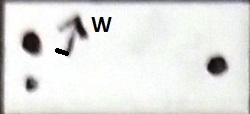
|
|
Frederik Wanink
Itterbeck (Germany) |
254mm |
STF2078 (AB) |

|
|
|
★★★
|
BU628 |
|
|
9m.5 |
9m.6 |
0.6" |
262° |
2016 |
Her |
17h18m22.22s / +32°39'38.50" |
|
|
Mark McCarthy
Fremont (California/USA) |
508mm (1067x) |
Wow split clean, amazing. No resolution at 667x but at 1067x two airy disks, sep by half disk, half delta mag. Remarkable |
|
|
|
★★★
|
COU994 |
|
|
9m.4 |
11m.2 |
0.5" |
214° |
2011 |
Her |
17h19m44.04s / +37°02'37.30" |
Mark McCarthy
Fremont (California/USA) |
508mm (1067x) |
At very best moments A presents a perfect disk, and a point resolves within the first faint diffraction ring, very faint and small Amazing. |
|
|
|
★★★
|
A2088 |
|
|
9m.9 |
10m.0 |
0.3" |
8° |
2014 |
Her |
17h20m32.37s / +47°38'51.50" |
Mark McCarthy
Fremont (California/USA) |
508mm (1067x) |
sharp and clean split in best moments, seeing lasts a couple seconds. Otherwise it's touching disks. |
|
|
|
★★★
|
COU1594 |
|
|
10m.7 |
10m.6 |
0.5" |
330° |
2014 |
Her |
17h33m59.60s / +44°28'45.60" |
Mark McCarthy
Fremont (California/USA) |
508mm (1067x) |
Needed to wait for seeing but a very extraordinarily fine point resolves with the best seeing, seems much fainter than data but it's definitely there, a hard point. |
|
|
|
★★★
|
COU1596 |
|
|
9m.3 |
9m.3 |
0.2" |
104° |
2007 |
Her |
17h42m14.40s / +44°22'59.10" |
Mark McCarthy
Fremont (California/USA) |
508mm (1067x) |
Olive to notched at best moments, equal stars |
|
|
|
★★★
|
STF2202, 61 Oph |
|
AB |
6m.1 |
6m.5 |
20.8" |
92° |
2019 |
Oph |
17h44m34.09s / +02°34'45.90" |
René Merting
Drachhausen (Germany) |
8x30 |
die B-Komponente ist östlich von A erkennbar, lässt sich aber noch nicht trennen - eine klassische Ameise |
|
René Merting
Drachhausen (Germany) |
10x35 |
ein richtig schöner Doppelstern für 10-fache Vergrößerung - zwei gleich helle Sterne, knapp getrennt |
|
René Merting
Drachhausen (Germany) |
10x50 |
ein ausgesprochen schönes knapp getrenntes Sternpaar - beide Sterne sind in etwas gleich hell - Komponente B im Osten ist nicht ganz so weiß wie A |
|
René Merting
Drachhausen (Germany) |
15x56 |
wunderschön - ein sauber getrenntes Sternpaar, wobei B im Osten nur minimal schwächer wirkt - beide Sterne zeigen sich strahlend weiß |
|
René Merting
Drachhausen (Germany) |
16x70 |
ein schön eng stehendes Pärchen, knapp getrennt - Komponente A im Westen ist nur leicht heller als B - beide Komponenten wirken weiß |
|
Uwe Pilz
Leipzig (Germany) |
16x70 |
beide gelb |
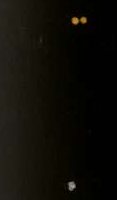
|
René Merting
Drachhausen (Germany) |
100mm (20x) |
bei 20x leicht zu trennen - Komponente B im Osten ist nur minimal schwächer (keine halbe Größenklasse, denke ich) - Komponente A stahlt ein wenig wärmer als B |
|
Sarah Gebauer
Germany |
150mm (30x) |
bei geringer Vergrößerung (30x) schon sauber getrennt, beide Sterne wirken gleich groß und gleich hell, ein nettes Pärchen |
|
Sarah Gebauer
Germany |
150mm (54x) |
zwei nicht ganz enge Glanzpünktchen in einer eher uninteressanten Umgebung |
|
Mark McCarthy
Fremont (California/USA) |
203mm (667x) |
Half delta mag wide separation white. |
|
|
Berthold Fuchs
Wiesbaden (Germany) |
130mm |
easy DS |

|
|
|
★★★
|
HU1288 |
|
|
8m.3 |
9m.4 |
0.4" |
163° |
2016 |
Her |
17h47m09.16s / +15°02'13.80" |
|
|
Mark McCarthy
Fremont (California/USA) |
508mm (1067x) |
Awesome! clean split, very clean star images. Split by half disk, half delta mag. very cool great catch! suspected at 667x, ramped up power to 1067x to split. |
|
|
|
★★★
|
S694 |
|
|
6m.7 |
7m.3 |
79.3" |
238° |
2018 |
Oph |
17h52m05.20s / +01°06'40.30" |
René Merting
Drachhausen (Germany) |
15x56 |
ein idealer FG-Doppelstern mit schön anzusehendem Farbkontrast - Komponente A im Osten strahlt reinweiß, hat ordentlich Abstand ist eine halbe Magnitude schwächer und wirkt weißgrau, fraglich wo bei diesen Farben der Farbkontrast herkommen soll, das Pärchen entfaltet trotzdem diese Wirkung |
|
Uwe Pilz
Leipzig (Germany) |
16x70 |
gelbweiß und blau; identisch WDS1752+0107 |

|
|
|
★★★
|
BU641 |
|
|
7m.0 |
8m.7 |
0.8" |
341° |
2015 |
Her |
18h21m48.44s / +21°30'27.90" |
Frederik Wanink
Itterbeck (Germany) |
254mm (640x) |
sehr schwierig |

|
Mark McCarthy
Fremont (California/USA) |
317mm (553x) |
Extraordinary! Moderately bright A and very much fainter B, 4-5 delta mag, <1" separation. Seeing needs to still. |
|
Mark McCarthy
Fremont (California/USA) |
508mm (533x) |
V989 Her. Seen as a snowman dot to bright white A @ 333x, split with 533x, inside first diffraction ring. Need A's disk to be perfectly tight for B to resolve with seeing. Very nice. 1" at discovery 1878 with Dearborn 18.5-inch |
|
|
|
★★★
|
epsilon Lyr |
STF2382, 4 Lyr, epsilon 1 Lyr |
AB |
5m.2 |
6m.1 |
2.2" |
345° |
2021 |
Lyr |
18h44m20.34s / +39°40'12.40" |
|
|
|
STFA37 |
AB-CD |
4m.7 |
4m.6 |
209.4" |
172° |
2021 |
|
|
|
|
|
STFA37 |
AI |
5m.2 |
10m.1 |
150.4" |
137° |
2021 |
|
|
|
|
|
STF2383, 5 Lyr, epsilon 2 Lyr |
CD |
5m.2 |
5m.4 |
2.3" |
75° |
2021 |
|
|
|
|
Christopher Hay
Seeheim (Germany) |
naked eye |
STFA37 (AB-CD): While waiting for Comet Neowise at 3 in the morning in July 2020 surprised myself with my first naked-eye separation of Alpha1 und Alpha2 Capricornis (observing site at 50° northern latitude, Alpha1/2 passing through meridian). Encouraged by this, I lay down and had a close look at Epsilon Lyrae, without really expecting to be able to split it naked-eye, having never succeeded previously. At first Epsilon Lyrae appeared as a very short dash of light. Then the dash resolved into two pinpoints. After 15 years in the hobby and at age 60, at last got Eps Lyr split! No precise prior PA knowledge. After memorising PA as seen naked-eye carefully, confirmed it with binoculars. Eps Lyr is the third-easiest physical double in the (northern hemisphere) summer sky for the naked eye, after Zeta UMa (much easier) und Alpha Lib (marginally easier). |
|
Christopher Hay
Seeheim (Germany) |
2x54 |
STFA37 (AB-CD): Clean split. Actually more pleasant than in 4x10 binoculars, presumably due to more steady handheld view. |
|
Robert Zebahl
Leipzig (Germany) |
55mm (59x) |
STF2382 (AB): At 42x slightly elongated, at 59x elongated and obviously notched. |
|
Robert Zebahl
Leipzig (Germany) |
55mm (59x) |
STF2383 (CD): At 42x clearly elongated, but without any visible notch. At 59x split with touching diffraction disks. |
|
Robert Zebahl
Leipzig (Germany) |
70mm (57x) |
STF2382 (AB): Obviously seen as figure '8'. |
|
Robert Zebahl
Leipzig (Germany) |
70mm (57x) |
STF2383 (CD): Split, but extremely tight with almost touching diffraction disks. |
|
René Merting
Drachhausen (Germany) |
76mm (95x) |
AB-CD: bei 29x schön getrennt erkennbar, ohne dass sich AB und CD schon trennen lassen
AB: bei 57x leicht länglich mit kleiner Einschnürung - bei 95x schön eng getrennt, B nördlich wirkt etwas schwächer- bei 127x wunderschön, das Sternpaar hat zwei Beugungsscheibchen, die wie ein Heiligenschein um die beiden Sterne stehen
CD: bei 57x eine 8 - bei 95x ein schön eng getrenntes Pärchen gleichheller Sterne - bei 127x wunderschön, das Sternpaar hat zwei Beugungsscheibchen, die wie ein Heiligenschein um die beiden Sterne stehen
EF und I: bei 127x sind alle drei Sterne (I 10.1 mag / E 12.3 mag / F 12.7 mag) erkennbar |
|
René Merting
Drachhausen (Germany) |
100mm (107x) |
AB: bei 64x ist das Sternpaar mit leichter Einschnürung und Nord-Süd-Ausdehnung erkennbar - beide Sterne stehen minimal enger zusammen als das südlichere Paar CD - bei 107x knappe Trennung, Komponente B nördlich ist mindestens eine halbe Größenklasse schwächer als A
CD: bei 64x als 8 mit Ost-West-Ausdehnung erkennbar - bei 107x knapp getrennt, beide Komponenten sind etwa gleich hell |
|
Sarah Gebauer
Germany |
100mm (136x) |
ein Test mit dem neuen Refraktor, um einen Vergleich zum 6''-Newton zu ziehen: bei 136x schon astrein getrennt, natürlich ziemlich eng und ganz fein getrennt, aber dennoch ein überraschend positives Ergebnis |
|
Robert Zebahl
Leipzig (Germany) |
102mm (125x) |
Stunning view of the components A-D and I! |

|
Uwe Pilz
Leipzig (Germany) |
105mm (26x) |
bei 22x nicht trennbar |

|
Jörg S. Schlimmer
Germany |
127mm (203x) |
easy to split |

|
Sarah Gebauer
Germany |
150mm (250x) |
August 2019 zum ersten Mal die nah beieinanderstehenden Komponenten sauber getrennt, ein grandioser Doppel-Doppel-Anblick |
|
Winfried Kräling
Marburg (Germany) |
152mm (175x) |
|

|
René Merting
Drachhausen (Germany) |
320mm (144x) |
AB: bei 72x ist erkennbar, in welche Richtung die Sterne elongieren, bei 43x dann ist eine deutliche 8 sichtbar - erst bei 206x lassen sich A und B zweifelsfrei trennen, zeigen sich aber auch schon ordentlich aufgebläht
CD: bei 103x ist die südliche Komponente als 8 erkennbar - bei 144x kann ich C und D trennen |
|
René Merting
Drachhausen (Germany) |
320mm (144x) |
bei 144x sind die Komponenten von AB und CD gerade so getrennt voneinander erkennbar, sie tanzen wie wild miteinander - mit Arperturmaske und Abblendung auf 120 mm zeigen die vier nun deutlich schwächeren Sterne schöne Beugungsscheibchen und sind besser getrennt voneinander sichtbar |
|
Uwe Pilz
Leipzig (Germany) |
320mm (200x) |
7 Komponenten!! A-B-C-D-E-F-I |

|
|
Berthold Fuchs
Wiesbaden (Germany) |
130mm |
Double-Double |
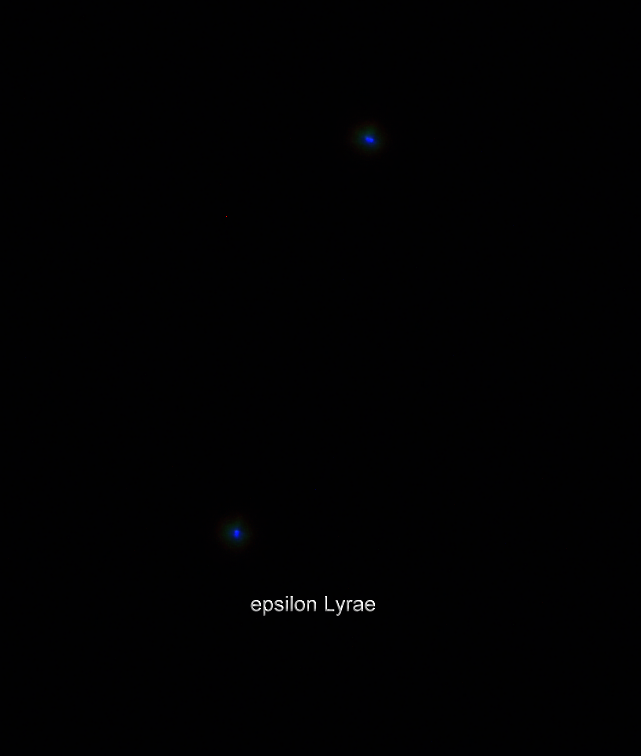
|
Frederik Wanink
Itterbeck (Germany) |
254mm |
|

|
|
|
★★★
|
beta Cyg, 6 Cyg, Albireo, STFA43 |
|
AB |
3m.2 |
4m.7 |
34.6" |
54° |
2022 |
Cyg |
19h30m43.29s / +27°57'34.90" |
Sarah Gebauer
Germany |
6x24 |
auf Anhieb schön getrennt, wenn auch sehr, sehr eng - der leichte Orangefarbton der Hauptkomponente ist sofort auszumachen, das Blau des Begleiters noch ganz zart und blass - wirklich entzückend in der Kleinstvergrößerung! |
|
Christopher Hay
Seeheim (Germany) |
7x42 |
Handheld binoculars in reclining chair. Following a surprisingly easy split of Zeta Lyr, I try out whether Albireo may also be splittable. Indeed, the pair is split, difficult but definite. Staring at Altair (Alpha Aql) for a few seconds with the binoculars prior to observing Albireo heigtens my acuity and makes the split more definite. Component A exhibits a mild orange-yellow hue. |
|
Robert Zebahl
Leipzig (Germany) |
8x40 |
Well split, but I didn't recognised any color. |
|
René Merting
Drachhausen (Germany) |
10x50 |
Komponente A ist gleißend hell und stroh-gelb, Komponente B ist deutlich schwächer leicht abgesetzt von A erkennbar und strahlt eigenartig mintgrün |
|
Christopher Hay
Seeheim (Germany) |
12x36 |
Well split. A golden-red, B cold blue. Gorgeous! |
|
René Merting
Drachhausen (Germany) |
12x42 |
ein bisschen mehr als knapp getrenntes Pärchen - A strahlt in einem schönen, hellen Gelb, B wirkt blaugrau - Helligkeitsunterscheid etwas mehr als eine Größenklasse |
|
Sarah Gebauer
Germany |
12x42 |
ein knackscharfes, farbiges, leuchtendes Paar, nach der Saisonpause endlich wieder sichtbar - A strahlt warm, orangegold, kräftig - B glitzert kristalleisblau klein daneben - ein traumhafter Anblick im Fernglas, die Sternumgebung nimmt sich scheinbar bewusst zurück und sprenkelt das Bild mit zahlreichen schwachen Sternen |

|
René Merting
Drachhausen (Germany) |
15x56 |
die Hauptkomponente strahlt in einem schönen buttergelb, die Komponente B zeigt sich westlich und wirkt bim ersten Eindruck mintgrün, der Farbeindruck verliert sich aber, je länger ich dieses schöne Sternpaar bewundere - Helligkeitsunterschied 1.5 bis 2 Größenklassen |
|
Robert Zebahl
Leipzig (Germany) |
16x70 |
2020-07-06: Bright orange & white-bluish. |
|
Robert Zebahl
Leipzig (Germany) |
80mm (25x) |
One of the most beautiful double stars in the northern hemisphere. Differences in brightness and color (orange-blue) are brilliant! Even under urban conditions with small aperture an enjoyment! |
|
René Merting
Drachhausen (Germany) |
100mm (32x) |
bei 32x stehen beide Sterne weit getrennt - Komponente A mit einem satten zitronen-gelb, Komponente B mit einem leichten Stich ins Blaue |
|
René Merting
Drachhausen (Germany) |
107mm (43x) |
bei 43x zeigt die hellere Komponente ein wunderschönes Samtgelb, kurz davor, ein richtig kräftiges Gelb zu sein - die schwächere Komponente wirkt auf den ersten Blick blauweiß |
|
Jörg S. Schlimmer
Germany |
127mm (203x) |
easy to split |

|
Sarah Gebauer
Germany |
150mm (116x) |
Erstbeobachtung August 2019: deutlicher Farbunterschied zwischen blau und sattem Gelb zu sehen |
|
Jörg S. Schlimmer
Germany |
305mm (170x) |
alle Komponenten einfach zu trennen |

|
René Merting
Drachhausen (Germany) |
320mm (45x) |
|

|
|
Frederik Wanink
Itterbeck (Germany) |
254mm |
Doppelsternnatur von MCA 55 nicht zu sehen |

|
Werner E. Celnik
Rheinberg (Germany) |
150mm |
|
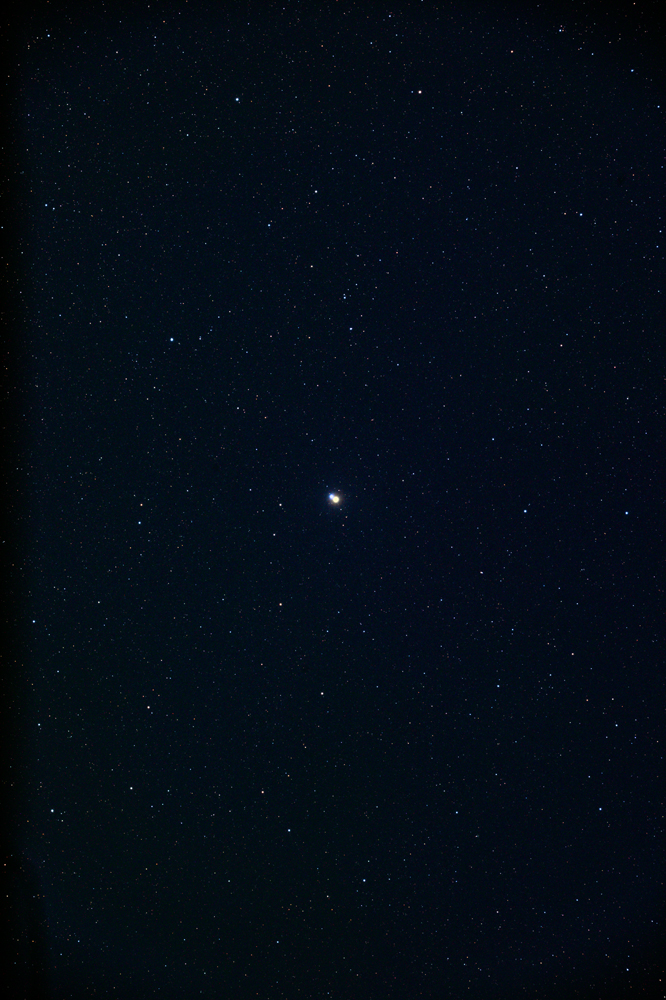

|
Werner E. Celnik
Rheinberg (Germany) |
150mm |
|

|
|
|
★★★
|
HN 84, V340 Sge |
|
|
6m.4 |
9m.5 |
28.4" |
301° |
2013 |
Sge |
19h39m25.33s / +16°34'16.00" |
René Merting
Drachhausen (Germany) |
12x42 |
man muss schon länger hinschauen, bevor die schwache Komponente nordwestlich leicht abgesetzt von A erkennbar ist |
|
Sarah Gebauer
Germany |
12x42 |
etwas mehr als knapp getrennt, A strahlt sehr schön dunkelgelb bis goldbraun |
|
René Merting
Drachhausen (Germany) |
12x50 |
verdammt schwer - Komponente B ist ganz schwach nordwestlich von A auszumachen - beide Sterne berühren sich noch |
|
René Merting
Drachhausen (Germany) |
16x70 |
beide Sterne präsentieren sich gut getrennt, nicht zu weit aber auch nicht zu nah - Komponente A meint es gut mit der Farbe gelb, bei Komponente B kann ich keine Farbe erkennen |
|
Christopher Hay
Seeheim (Germany) |
80mm (30x) |
Primary ruddy red, secondary wide apart but too faint for any colour impression. Straw-yellow Epsilon Saggitae half a degree to the west with its ice-blue eastern companion enhances the experience of colour contrast in the FOV and is actually more attractive than HN 84 with this aperture and power. |
|
René Merting
Drachhausen (Germany) |
100mm (20x) |
bei 20x sind beide Komponenten weit getrennt - Komponente A auffällig gelb-orange, B dagegen grau-blau, ein schöner Farbkontrast, der sich bei 32x verstärkt |
|
Sarah Gebauer
Germany |
150mm (85x) |
Holden 84, eine sehr goldgelbe Komponente und in 28'' Abstand die zweite, sehr schwache und weiße Komponente mit einem Hauch von Blau, sehr, sehr schön! |
|
Christopher Hay
Seeheim (Germany) |
150mm (96x) |
Main component ruddy tangerine orange, companion wide apart and ice blue. The longer I look the stronger the colour contrast becomes, which is by no means normal in many doubles. Epsilon Saggitae in same 0.8-degree field of view is straw-yellow with a cold blue companion (a field star?) pointing away from Epsilon in the direction of HN 84. I can’t think offhand of a better colour-contrast pair that can be framed in this manner in the same FOV. |
|
Sarah Gebauer
Germany |
150mm (160x) |
die hellere Hauptkomponente ist deutlich und stark goldfarben, die zweite dagegen sehr schwach, silbrig und dumpf |

|
Mark McCarthy
Fremont (California/USA) |
178mm (205x) |
Very pretty orange A and neon blue B, 1 delta mag, very wide |
|
René Merting
Drachhausen (Germany) |
320mm (103x) |
bei 45x weit getrennt, für den Farbeindruck aber auf 103x vergrößert, dann strahlt A in einem tiefsatten Gelb - B im Westen wirkt beiläufig betrachtet Türkis bis Blaugrau - wenn ich mich aber auf B konzentriere, verwandelt sich der Stern in eine grauweiße Maus |

|
|
|
★★★
|
STFA50, 30/31 Cyg, omicron Cyg |
|
AC |
3m.9 |
7m.0 |
108.6" |
173° |
2016 |
Cyg |
20h13m37.90s / +46°44'28.80" |
|
|
|
|
AD |
3m.9 |
4m.8 |
336.7" |
322° |
2016 |
|
|
Robert Zebahl
Leipzig (Germany) |
naked eye |
AD: Well split with noticeable difference in brightness. |
|
René Merting
Drachhausen (Germany) |
naked eye |
meist sehe ich nur einen diffusen Lichtpunkt und dann irgendwann … immer wieder sind A und D klar erkennbar und getrennt voneinander zu sehen - D steht in Richtung Nordwesten von A aus gesehen |
|
Sarah Gebauer
Germany |
naked eye |
AC: 16.09.23 Jeßnigk: Ohne zu wissen, dass es möglich ist, lässt sich Omicron 1 Cygni in beide Komponenten auftrennen - mit deutlichem Helligkeitsunterschied und sichtbarem Abstand zueinander sind beide Sterne sehr gut einzeln zu sehen |
|
Christopher Hay
Seeheim (Germany) |
3x63 |
AD: Self-built binoculars, hence the unusual specification.
Widely split, A (31 Cyg) light orange, D (30 Cyg) light blue. |
|
Christopher Hay
Seeheim (Germany) |
7x50 |
A-D: Widely split, A (31 Cyg) luminous orange-red, D (30 Cyg) luminous ice-blue. C set off from A as a fine speck of light. |
|
Robert Zebahl
Leipzig (Germany) |
8x40 |
AC: Observation at full moon. Easily split with big difference in brightness. Brighter component slightly orange. C component rather faint. |
|
Robert Zebahl
Leipzig (Germany) |
8x40 |
AD: Wonderful double star for binoculars. Large distance of the components, brighter once (31 Cyg) appeared slightly orange, the fainter (Cyg 30) more bluish. |
|
Christopher Hay
Seeheim (Germany) |
15x45 |
A-D: Very wide apart but still perceived as belonging together. A (31 Cyg) orange-red, D (30 Cyg) ice-blue. C well set off from A and light ice-blue, like an echo of D. A delightful group of three for binoculars at this power, further accentuated by nearby orange Omicron2 Cygni. Both the brightnesses and colour hues of Omi1A and Omi2 appear practically identical. |
|
Robert Zebahl
Leipzig (Germany) |
16x70 |
2020-07-03: Fantastic sight. A: bright orange, D: white-bluish, C: light blue. Very beautiful field. |
|
René Merting
Drachhausen (Germany) |
18x70 |
wunderschön - Komponente A präsentiert sich buttergelb - die südliche, schwächste Komponente C zeigt sich aquamarinblau - D im Norden ist reinweiß und steht dreimal weitere entfernt wie AC |
|
René Merting
Drachhausen (Germany) |
76mm (57x) |
Mondscheinnacht - bei 29x ein wunderschönes Sterntrio, A wirkt goldgelb, D weiß mit einem Stich ins türkise, C ist kühlweiß mit einem Stich ins Blaue |

|
Robert Zebahl
Leipzig (Germany) |
80mm (25x) |
AC: Similar to the observation with binoculars. C component appeared bluish and gave good contrast to the orange colored 31 Cyg. |
|
René Merting
Drachhausen (Germany) |
100mm (32x) |
bei 32x sind alle drei Sterne weit getrennt und doch irgendwie zusammengehörend, Komponente A ist rapsgelb und am auffälligsten, Komponente D strahlt weiß und die schwächste Komponente C schimmert bläulich, schöner Anblick |
|
Robert Zebahl
Leipzig (Germany) |
102mm (28x) |
Bright, wide apart and wonderful contrast in color. A: light yellowish-orange, C: blue, D: light blue. |

|
René Merting
Drachhausen (Germany) |
107mm (30x) |
|

|
Sarah Gebauer
Germany |
150mm (30x) |
die drei Komponenten plus Omicron2 bilden ein wunderschönes, sehr langes und spitzes Dreieck und zeigen dabei wundervolle Farben, Komponente A von o1 sowie o2 erscheinen schön gelblich, Komponente D von o1 hat einen deutlichen Blaustich im Weißen, wirklich ein sehr schönes Gesamtbild - auf Komponente C hatte ich nicht geachtet |

|
Sarah Gebauer
Germany |
150mm (85x) |
dieses Mal nur die drei dicht beieinanderstehenden Komponenten A, C und D im Sichtfeld gehabt, Komponente A ist wieder deutlich gelbgold, C wirkt leicht bläulich und Komponente D wirkt dieses Mal eher weiß |

|
|
|
★★★
|
BLL49, U Cyg |
|
|
8m.0 |
9m.0 |
65.4" |
231° |
2015 |
Cyg |
20h19m41.66s / +47°54'19.90" |
|
|
Robert Zebahl
Leipzig (Germany) |
16x70 |
2020-07-03: Easy split with very good color contrast: white and clear orange. |
|
Sarah Gebauer
Germany |
100mm (80x) |
20.09.23: absolut vergleichbar mit der Beobachtung mit dem 10''-Spiegel, alle Sterne wirken nur etwas schwächer, der Farbeindruck ist jedoch genau so intensiv |

|
Robert Zebahl
Leipzig (Germany) |
102mm (28x) |
2019-08-22: While the primary component appears quite unspectacular in a white, the companion U Cygni is much more interesting. It is a carbon star whose brightness varies between 5m9 and 12m1 with a period of about 463 days. It appears in mostly intensely orange, and even deep red in the towards its minimum. Extremely rewarding! |
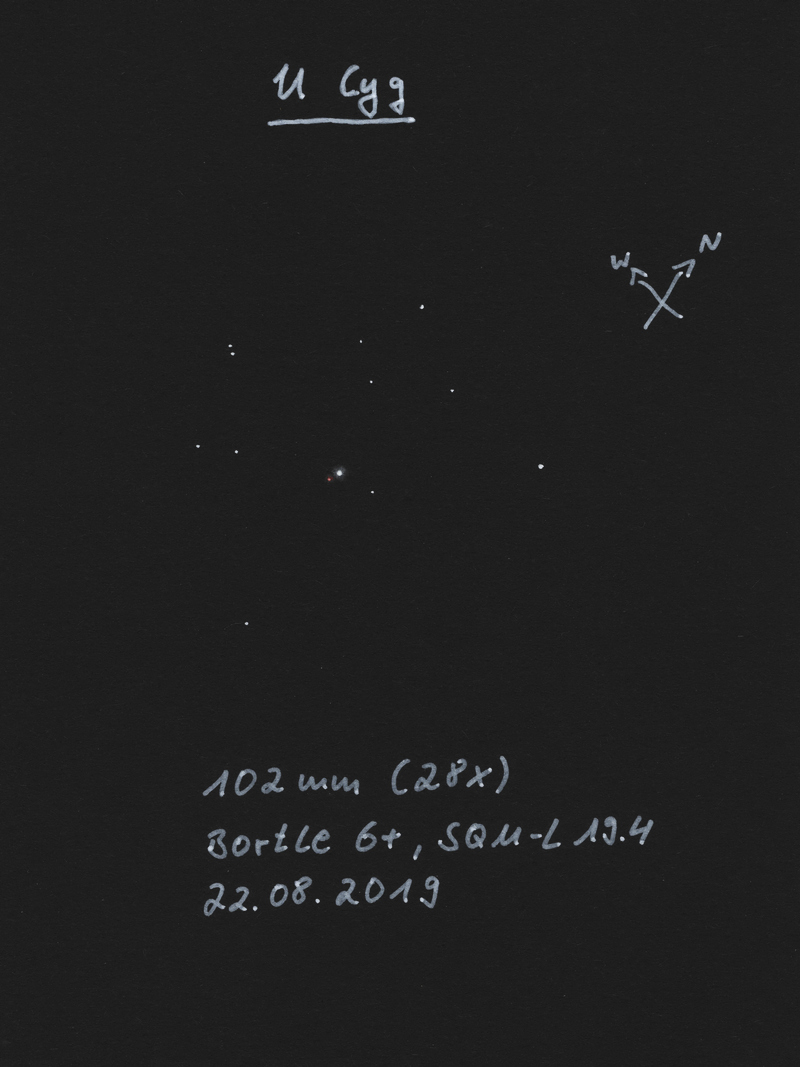
|
Sarah Gebauer
Germany |
254mm (96x) |
12.09.23: abartig krebsrot, richtig metallisch, dunkel, stark und ein richtiger Kracher bei 96-fach - der Begleiter im Nordosten mit recht weitem Abstand zeigt ein ganz zartes, hellbuttriges Cremegelb |

|
René Merting
Drachhausen (Germany) |
320mm (72x) |
|

|
|
|
★★★
|
STF2742 |
|
|
7m.4 |
7m.6 |
3.0" |
213° |
2021 |
Equ |
21h02m12.51s / +07°10'47.30" |
Robert Zebahl
Leipzig (Germany) |
70mm (57x) |
At 44x almost split with slight difference in brightness. At 57x split, but tight. |
|
René Merting
Drachhausen (Germany) |
100mm (64x) |
ähnlich wie STF2765 und STF2786 weiter nördlich wieder so ein knappes Pärchen bei 64x, das scheint Sternbild-typisch zu sein - beide Sterne sind fast gleich hell, der Stern im NO ist minimal heller |
|
Uwe Pilz
Leipzig (Germany) |
105mm (94x) |
Prachtstück! Weiß-Weißgelb. |

|
Mark McCarthy
Fremont (California/USA) |
317mm (553x) |
equal light orange, well split, pretty |
|
René Merting
Drachhausen (Germany) |
320mm (144x) |
bei 144x ein relativ enges Sternpaar zweier relativ gleich heller Sterne, B im Südwesten ist annähernd so hell wie A und beide Sterne strahlen reinweiß |
|
|
|
★★★
|
STF2758, 61 Cyg |
|
AB |
5m.2 |
6m.0 |
31.9" |
154° |
2021 |
Cyg |
21h06m53.95s / +38°44'57.90" |
|
|
Christopher Hay
Seeheim (Germany) |
8x42 |
On tripod. Clearly split, northern component A substantially brighter than B. Both orange, whereby A is distinctly more yellowish than B (sky quality similar to that of earlier 15x45 and 10x42 observations). Also seems to be split using the 8x42 handheld, but hand tremor makes this uncertain. |
|
Christopher Hay
Seeheim (Germany) |
15x45 |
Clear to wide separation. Both components of orange hue. Brighter northern component seemed to go slightly into yellow. In 10x42 also clearly split, northern component of orange hue, southern component of indeterminate colour (sky not quite dark enough at the time to see 61 Cyg naked-eye). Piazzi’s Flying Star, flying more than 5” per year to the northeast, and a true physical double with a period of 678 years. |
|
Robert Zebahl
Leipzig (Germany) |
16x70 |
2021-06-14: Beautiful sight. Bright orange & orange. |
|
Sarah Gebauer
Germany |
100mm (21x) |
20.09.23: der DS hebt sich bei 20-fach sehr stark vom Umfeld ab, das typisch für das Sternbild Schwan fein und üppig funkelnd wirkt - absolut mittig, wie auf dem Präsentierteller, zeigt sich der DS kupferbraun leuchtend mit einem geringen Helligkeitsunterschied, ein fantastischer Anblick - bei 49-fach ist der Farbeindruck leicht abgeschwächt, auch der Gesamteindruck leidet aufgrund geringeren Gesichtsfeldes |
|
René Merting
Drachhausen (Germany) |
100mm (32x) |
bei 32x sind beide Sterne gut getrennt, Komponente A strahlt in einem schmutzig dunklem gelb, schwächere Komponente B leicht orange |
|
Uwe Pilz
Leipzig (Germany) |
105mm (200x) |
gelb und orange. Der weitere Stern im Bild ist TYC 3168-6781 |

|
Uwe Pilz
Leipzig (Germany) |
105mm (200x) |
TYC 3168-5901 kann dazu dienen, den sich ändernden Positionswinkel abzuschätzen. |

|
Jörg S. Schlimmer
Germany |
127mm (203x) |
Intensive Farbe |

|
Robert Zebahl
Leipzig (Germany) |
152mm (22x) |
2020-06-24: Beautifully separated, bright, striking, especially the colors: bright orange and orange. |
|
Mark McCarthy
Fremont (California/USA) |
152mm (175x) |
61 Cyg. Stunning pair, yellow A and orange B, half delta mag, wide. Spectral class K5V+K7V (yellow-orange/yellow-orange). Only 11.38 light years away! Physical with a 618.6911-year period, it is now at apastron. There are 18 stars in the system but none of the visible ones are, and those only detected in K-band are uncertain |
|
Mark McCarthy
Fremont (California/USA) |
203mm (121x) |
61 Cyg. Nice near equal wide orange pair, bright [18 stars in system -- if so should be an OC] |
|
René Merting
Drachhausen (Germany) |
320mm (45x) |
bei 32x sind beide Sterne gut getrennt, Komponente A strahlt in einem schmutzig dunklem gelb, schwächere Komponente B leicht orange |

|
Uwe Pilz
Leipzig (Germany) |
320mm (121x) |
Der Doppelstern bildet 2021 mit dem 11-mag-Stern ein fast gleichschenkliges Dreieck |

|
|
Berthold Fuchs
Wiesbaden (Germany) |
130mm |
easy DS |

|
|
|
★★★
|
STF2854 |
|
|
7m.8 |
7m.9 |
1.6" |
84° |
2017 |
Peg |
22h04m22.52s / +13°38'53.40" |
Robert Zebahl
Leipzig (Germany) |
70mm (133x) |
Observed at 133x and 160x. Clearly elongated, from time to time with very little indentation. The air could have been steadier. |
|
Uwe Pilz
Leipzig (Germany) |
105mm (200x) |
|

|
Mark McCarthy
Fremont (California/USA) |
152mm (175x) |
Nice! Very fine near equal blue-white stars. WDS uncertain, but they are likely gravitational with 45% parallax range overlap, 130 AU weighted separation, 1.42/1.37 solar mass |
|
Mark McCarthy
Fremont (California/USA) |
203mm (533x) |
Striking pair, more near equal then 1 delta mag in Sky Tools. 2", white. Very nice. |
|
|
|
★★★
|
BVD142 & TDT3916 |
BVD142 |
AB |
7m.8 |
10m.3 |
80.0" |
165° |
2018 |
And |
23h10m29.28s / +41°19'18.70" |
|
|
|
TDT3916 |
Ba-Bb |
10m.7 |
11m.4 |
0.6" |
89° |
1991 |
|
|
Mark McCarthy
Fremont (California/USA) |
317mm (553x) |
BVD142 (AB): Orange stars, 1 delta mag, well separated (finder split). B looks suspiciously like a pair -- but the transparency may be causing it to smear. This is quite an amazing catch considering the conditions! AB is as described 7.80/10.28 79.6". B is indeed a pair: TDT 3916 = BaBb, 10.69/11.41 0.6". Discovered in 1991 and only one observation! |
|
Mark McCarthy
Fremont (California/USA) |
317mm (553x) |
TDT3916 (Ba-Bb): Orange stars, 1 delta mag, well separated (finder split). B looks suspiciously like a pair -- but the transparency may be causing it to smear. This is quite an amazing catch considering the conditions! AB is as described 7.80/10.28 79.6". B is indeed a pair: TDT 3916 = BaBb, 10.69/11.41 0.6". Discovered in 1991 and only one observation! |
|
|





